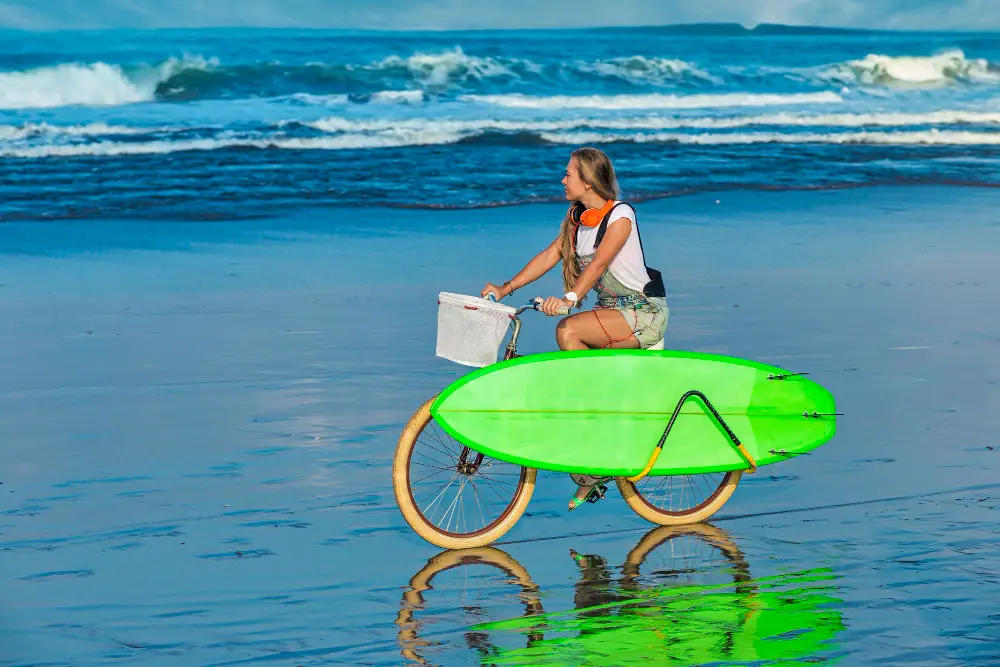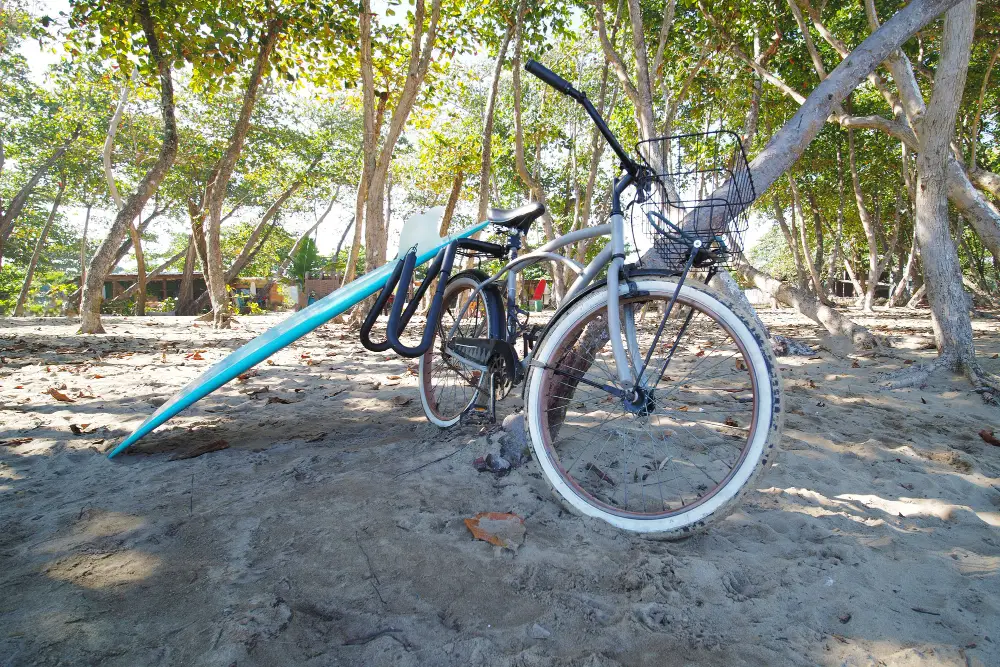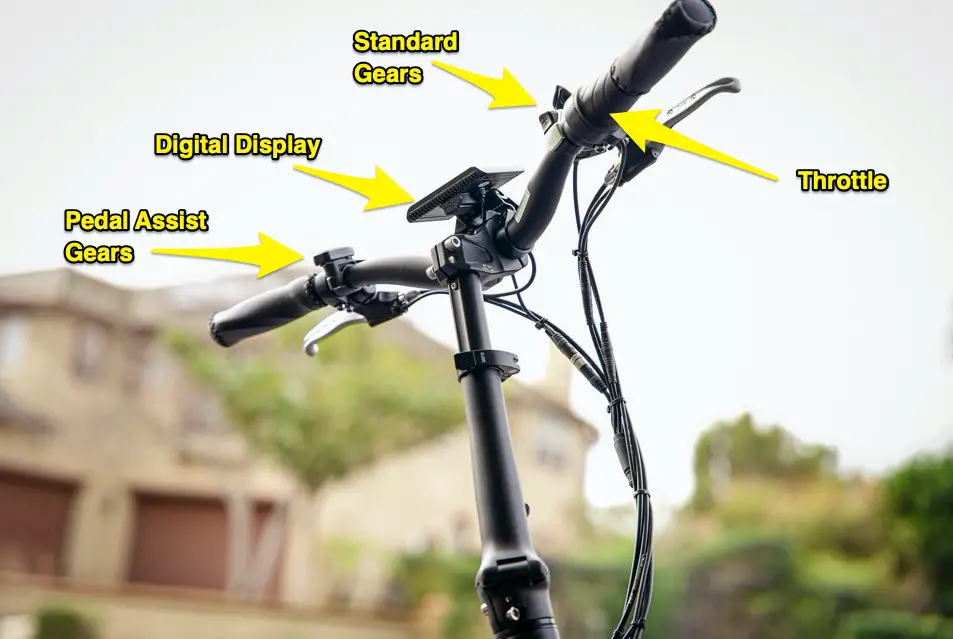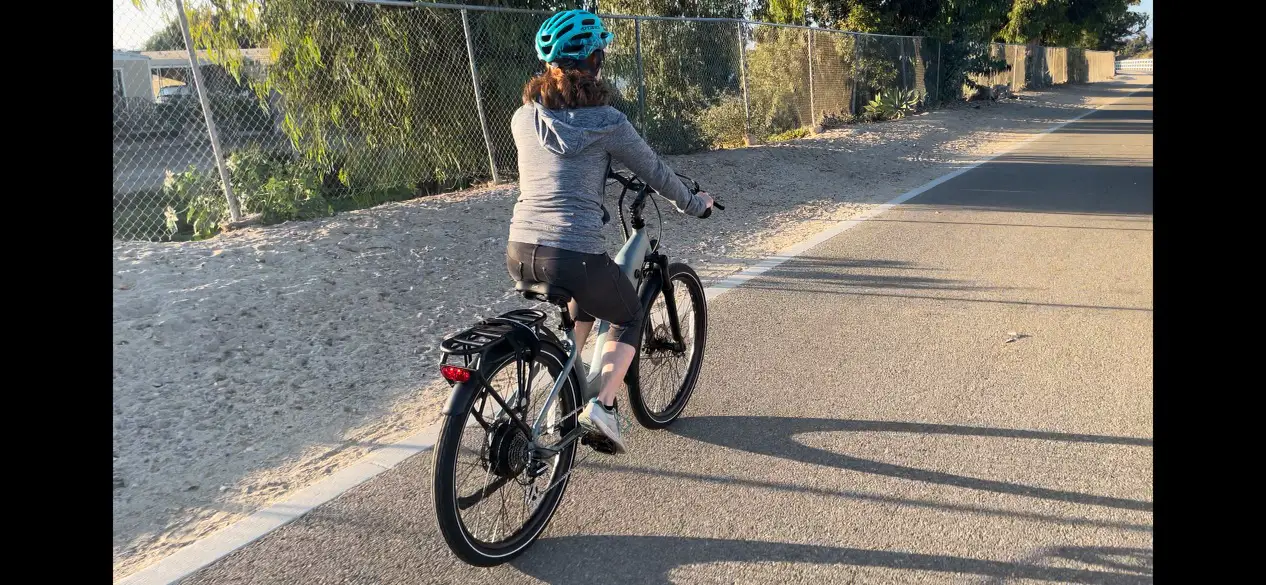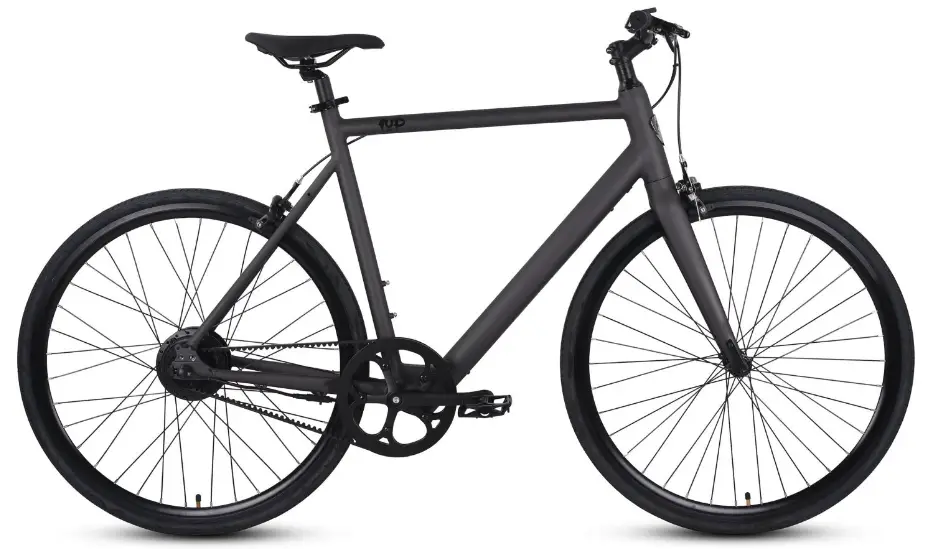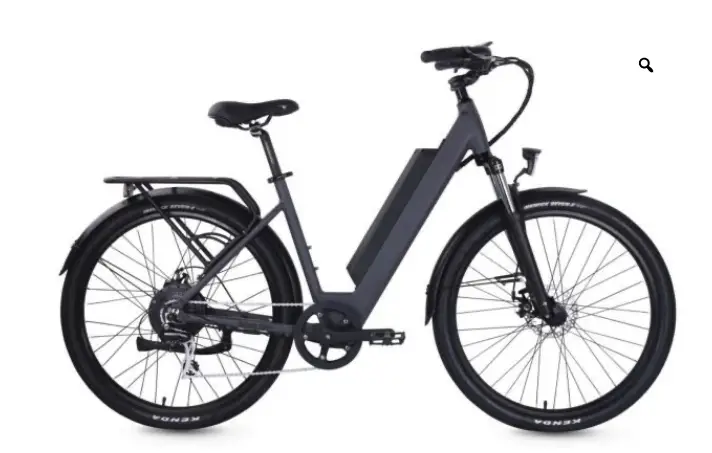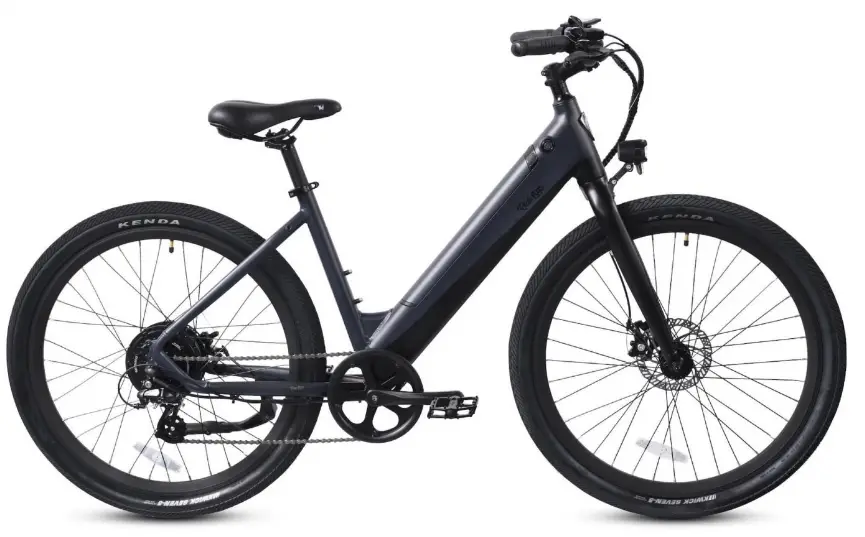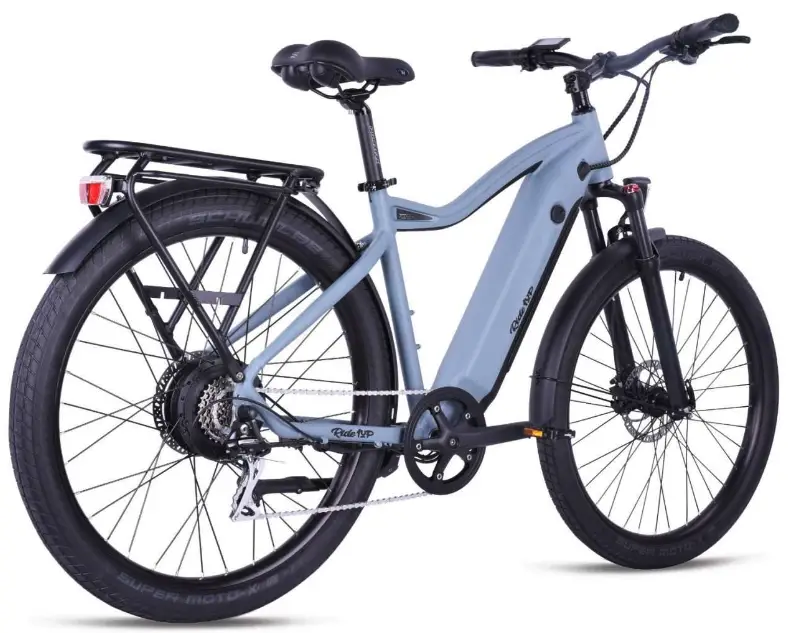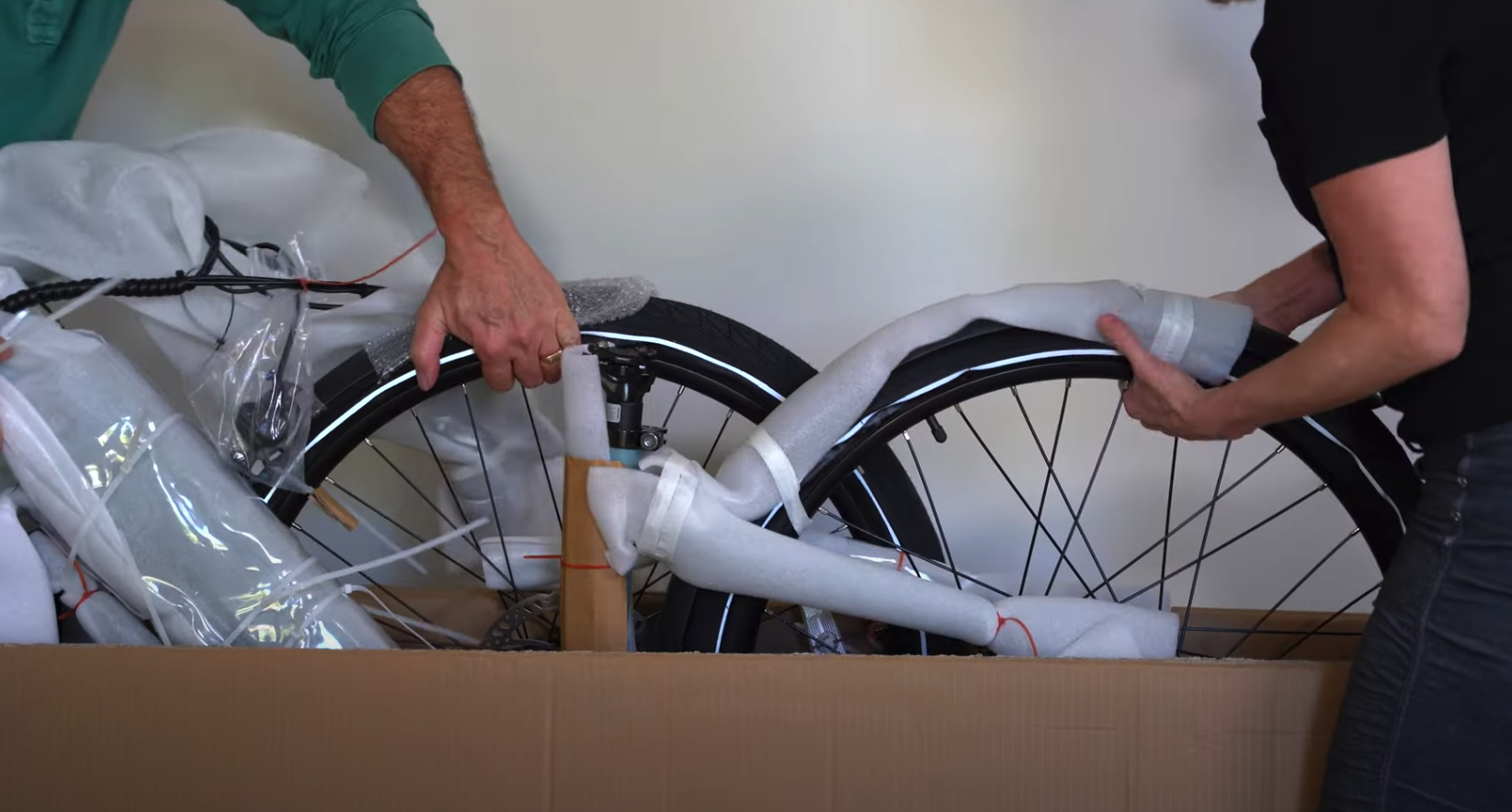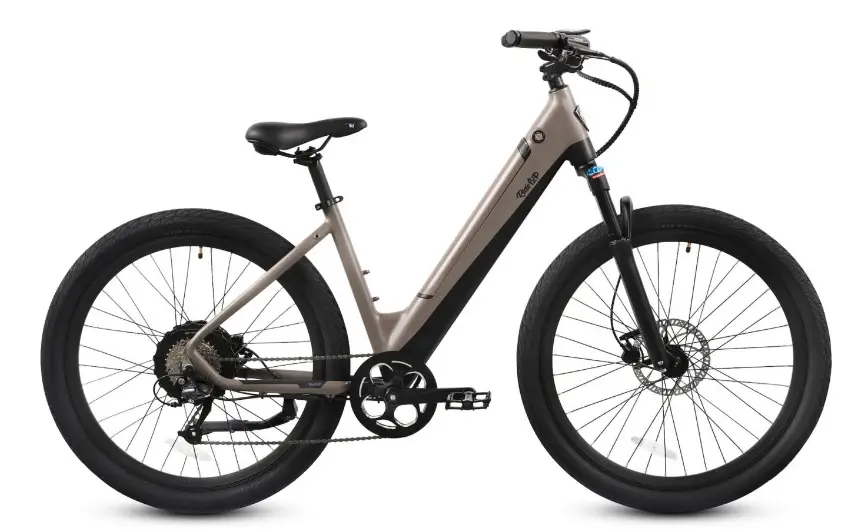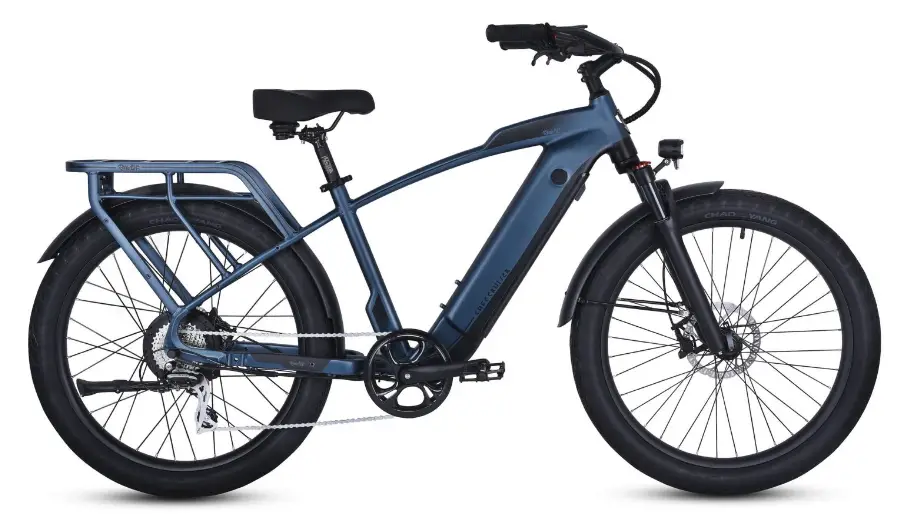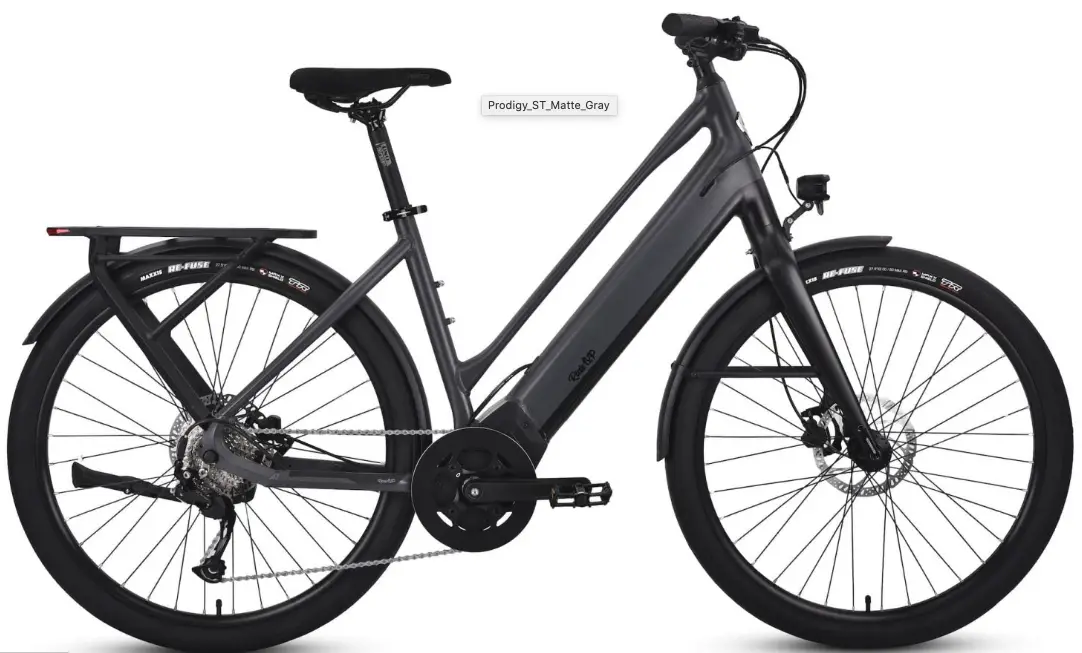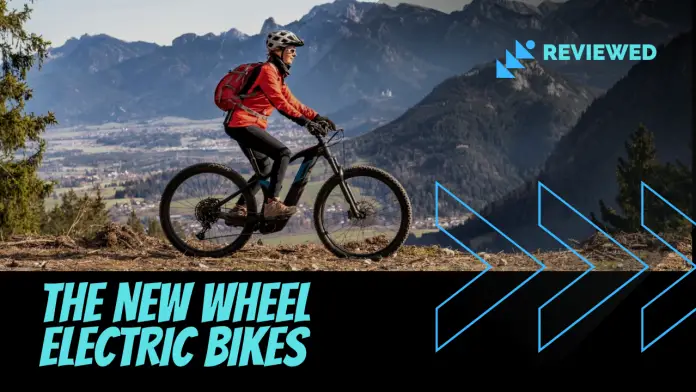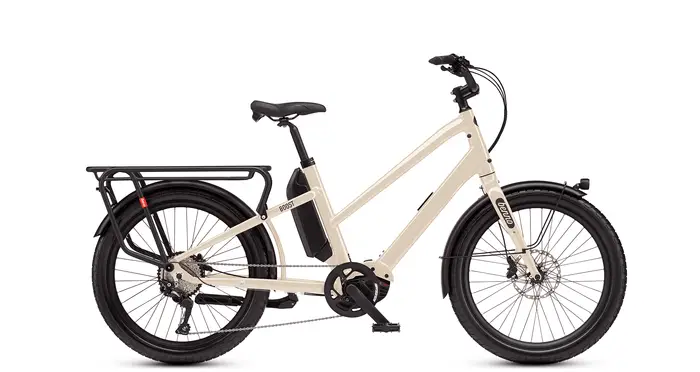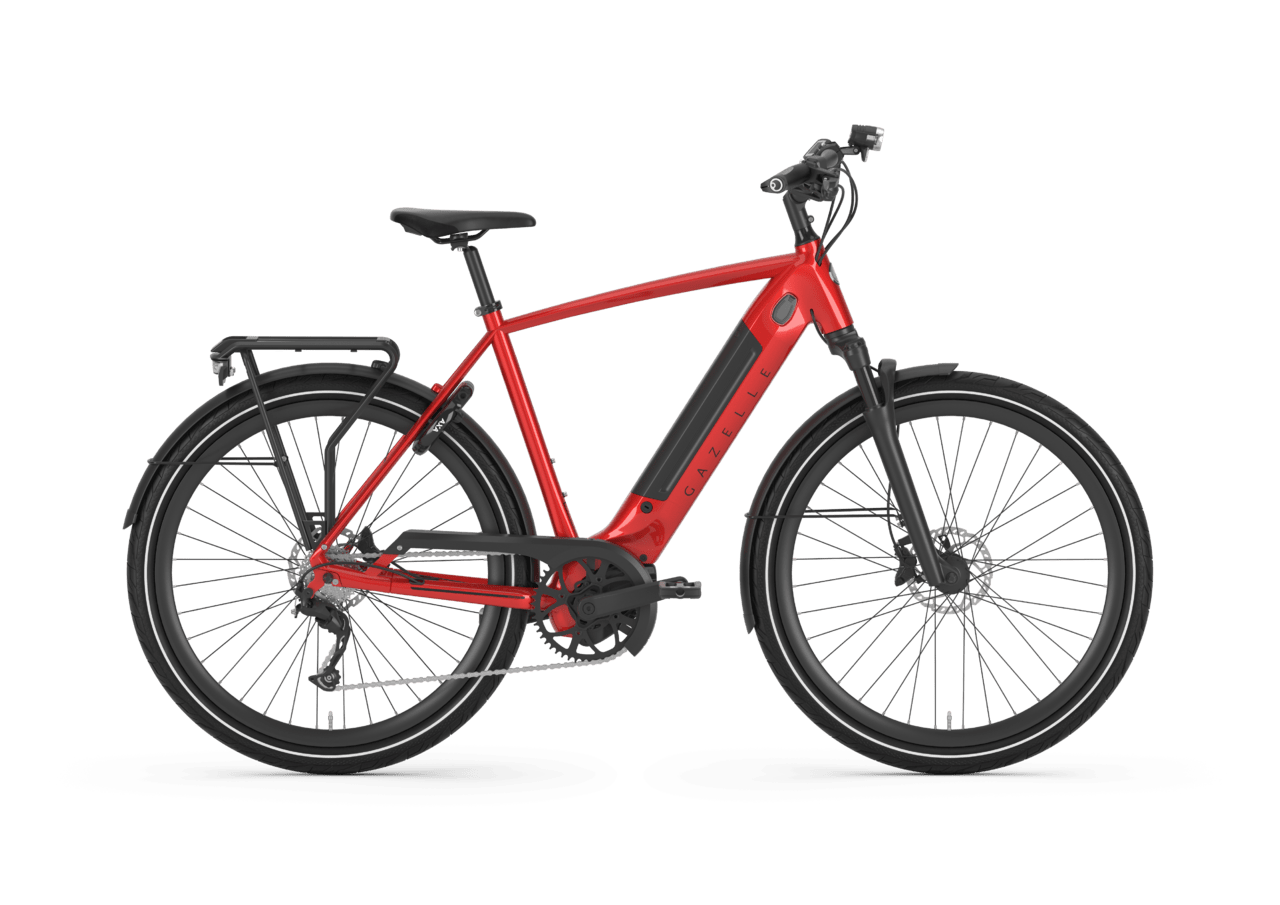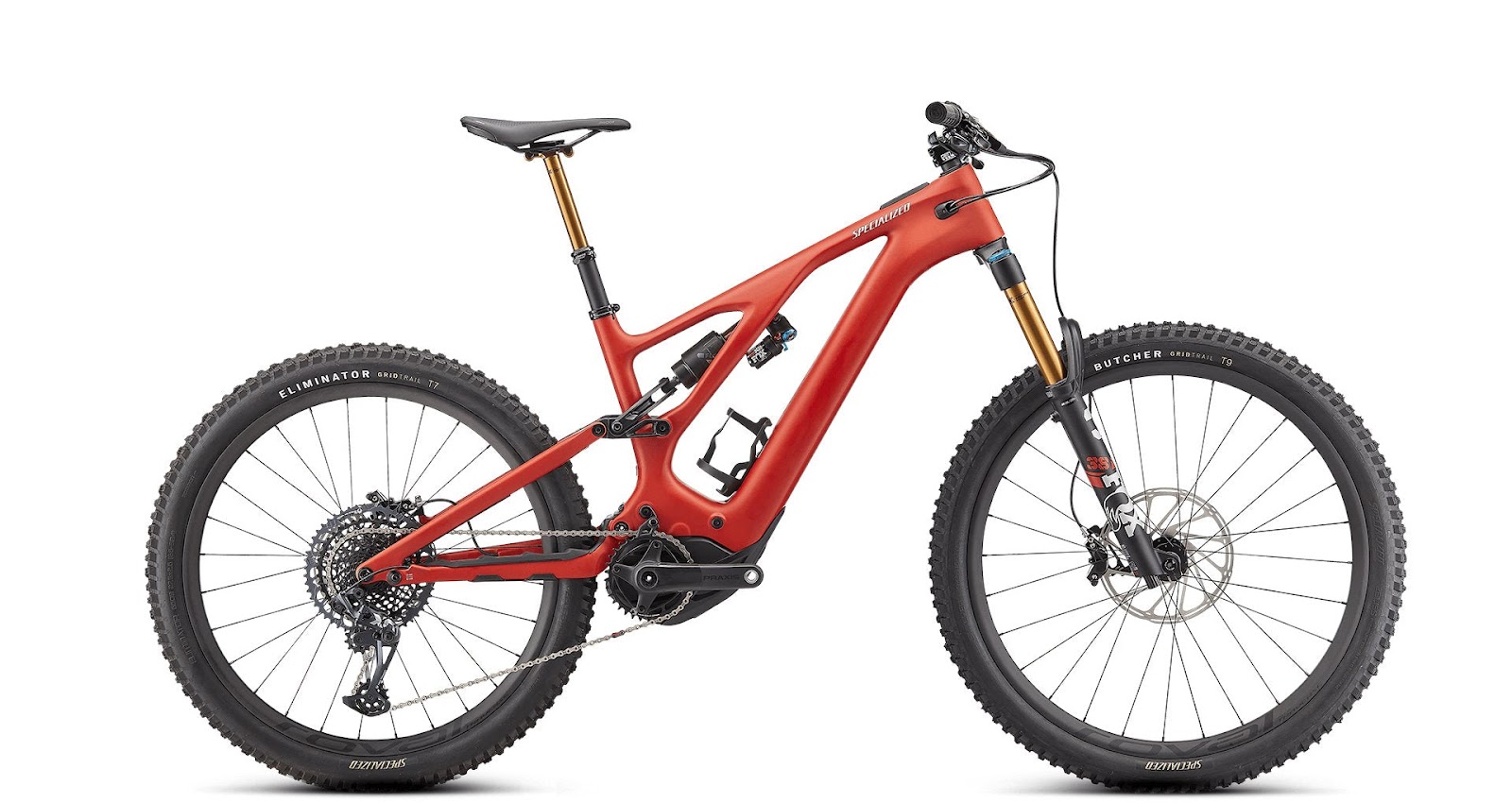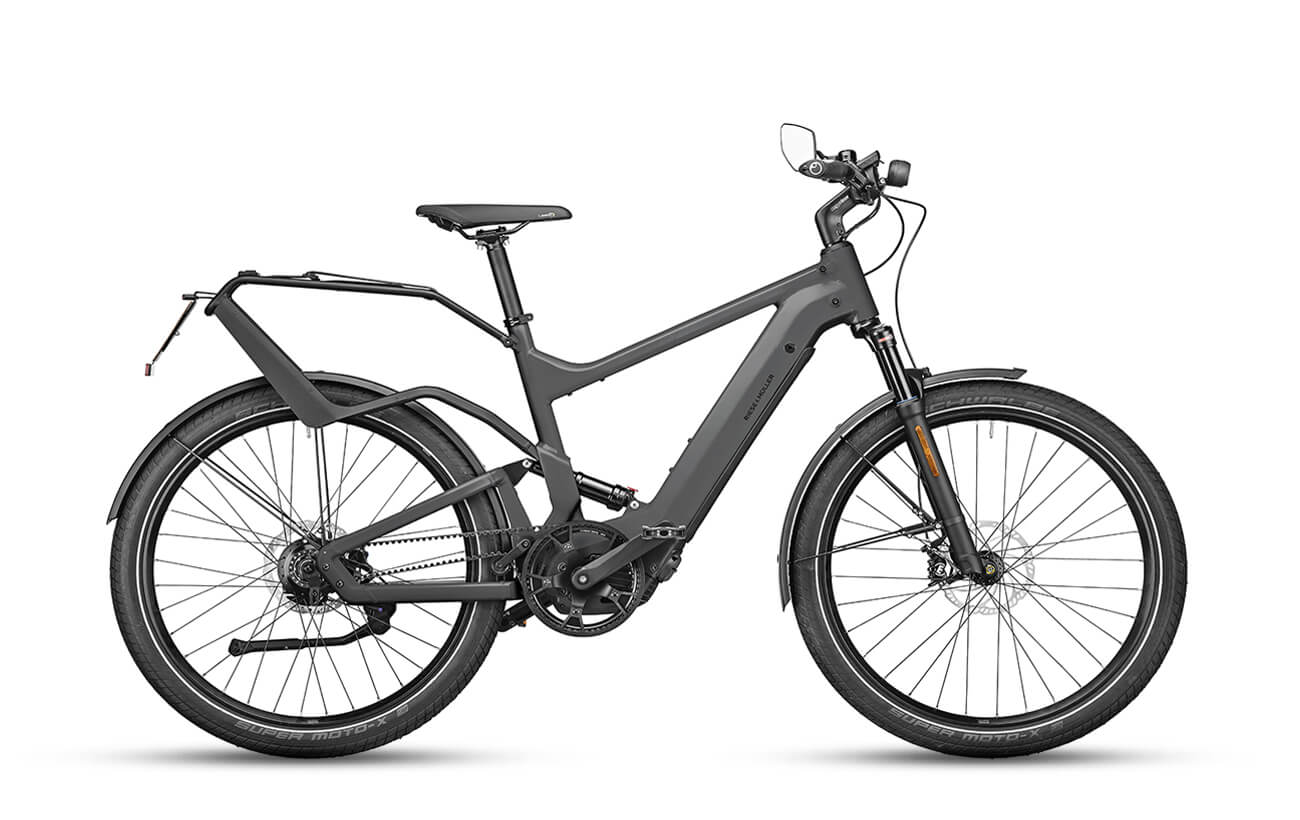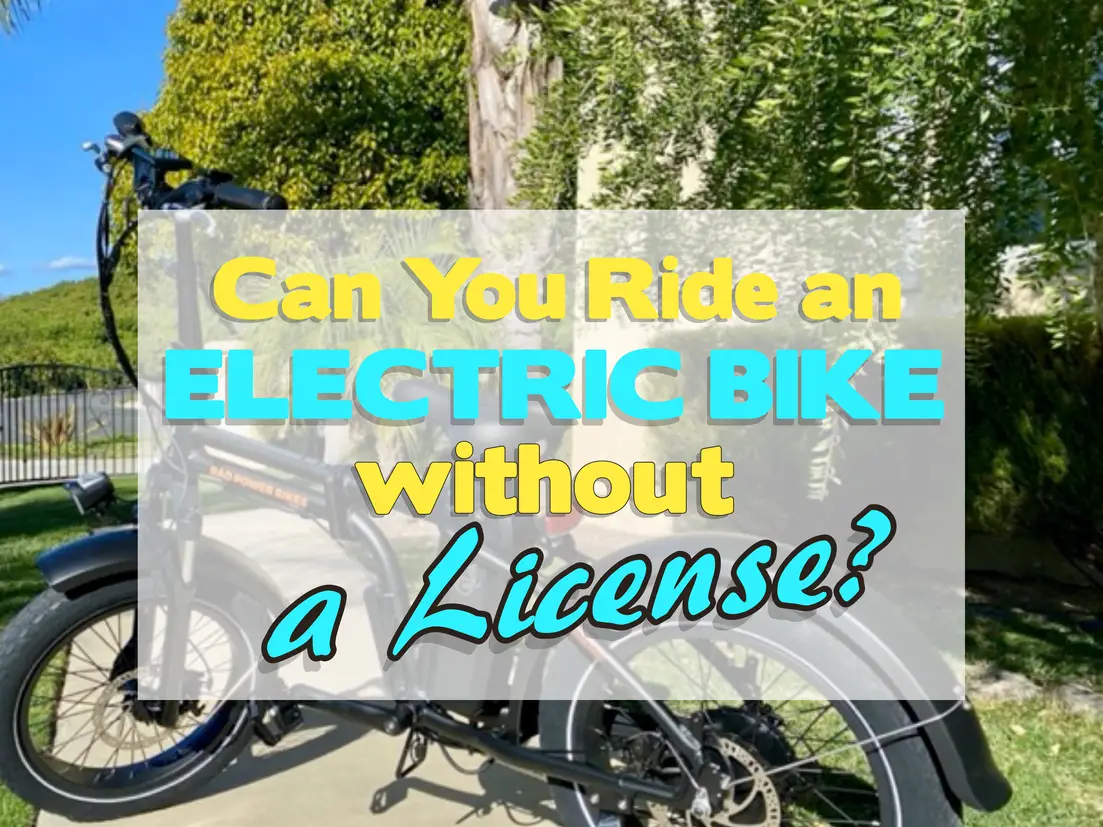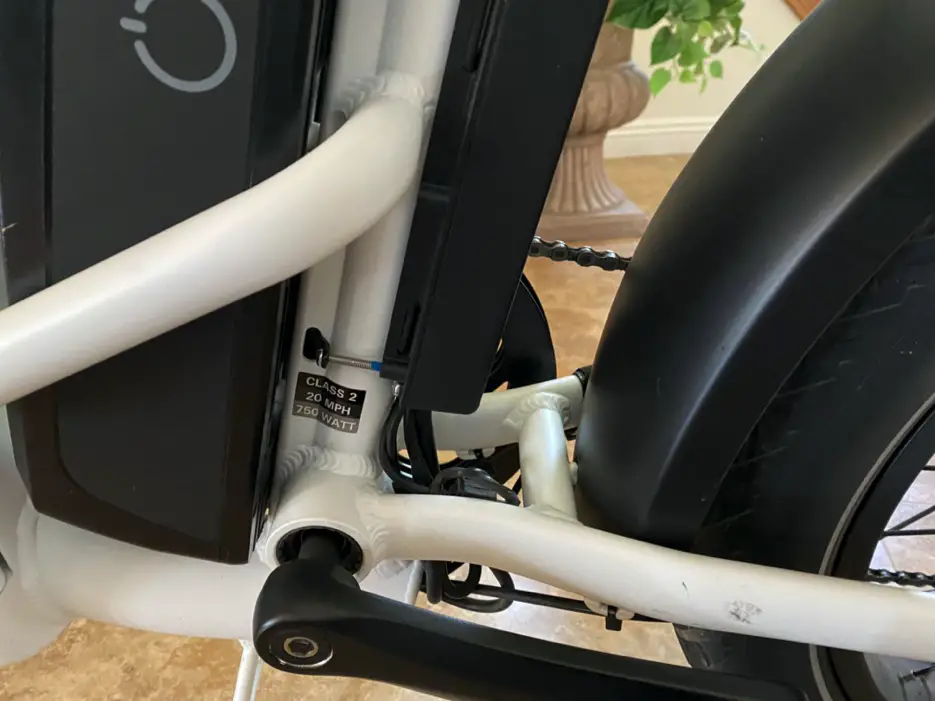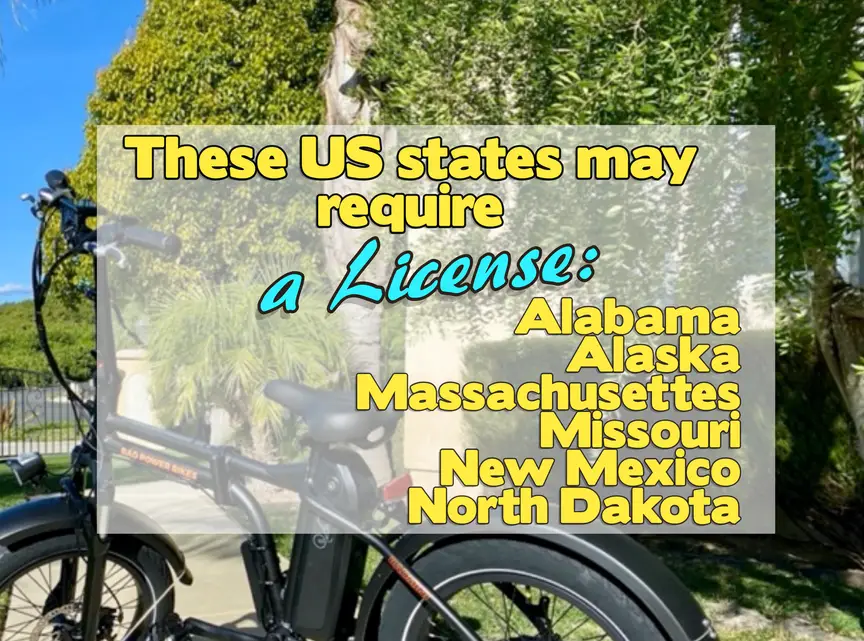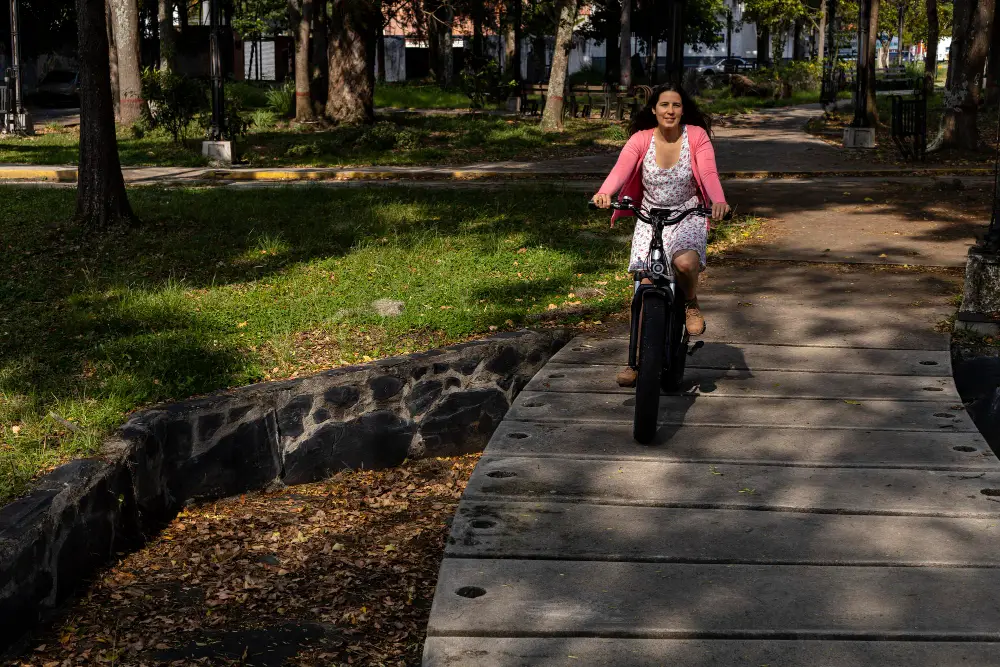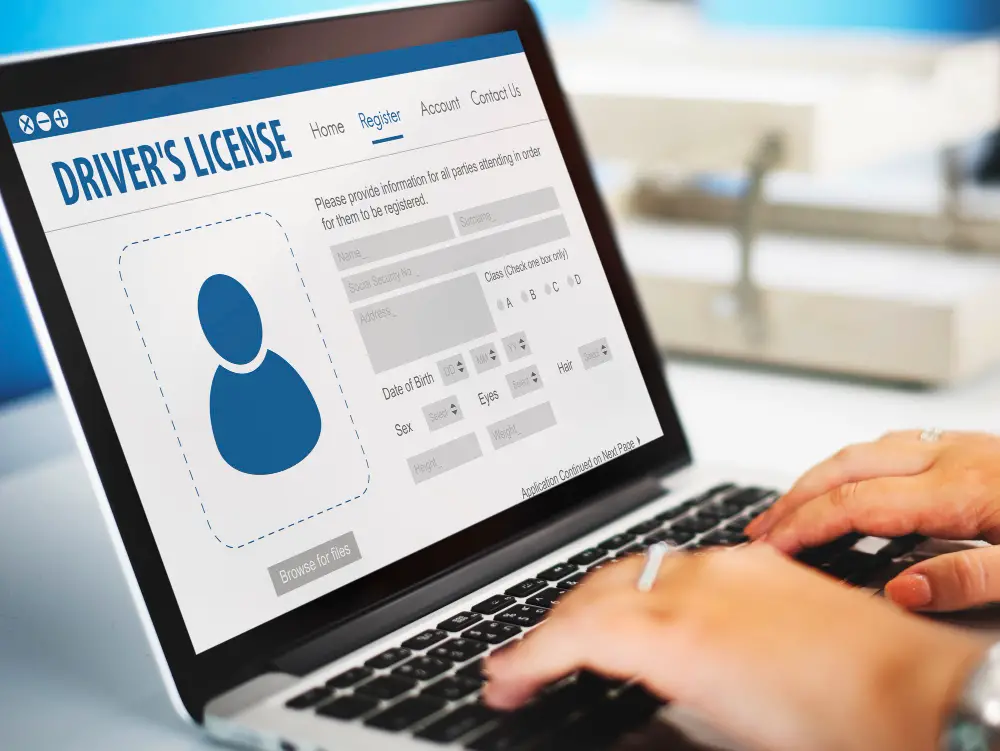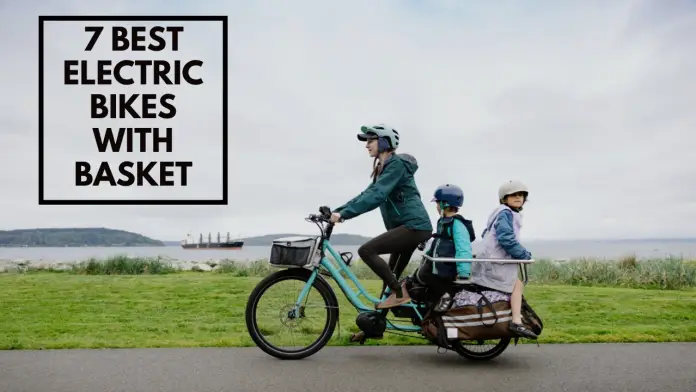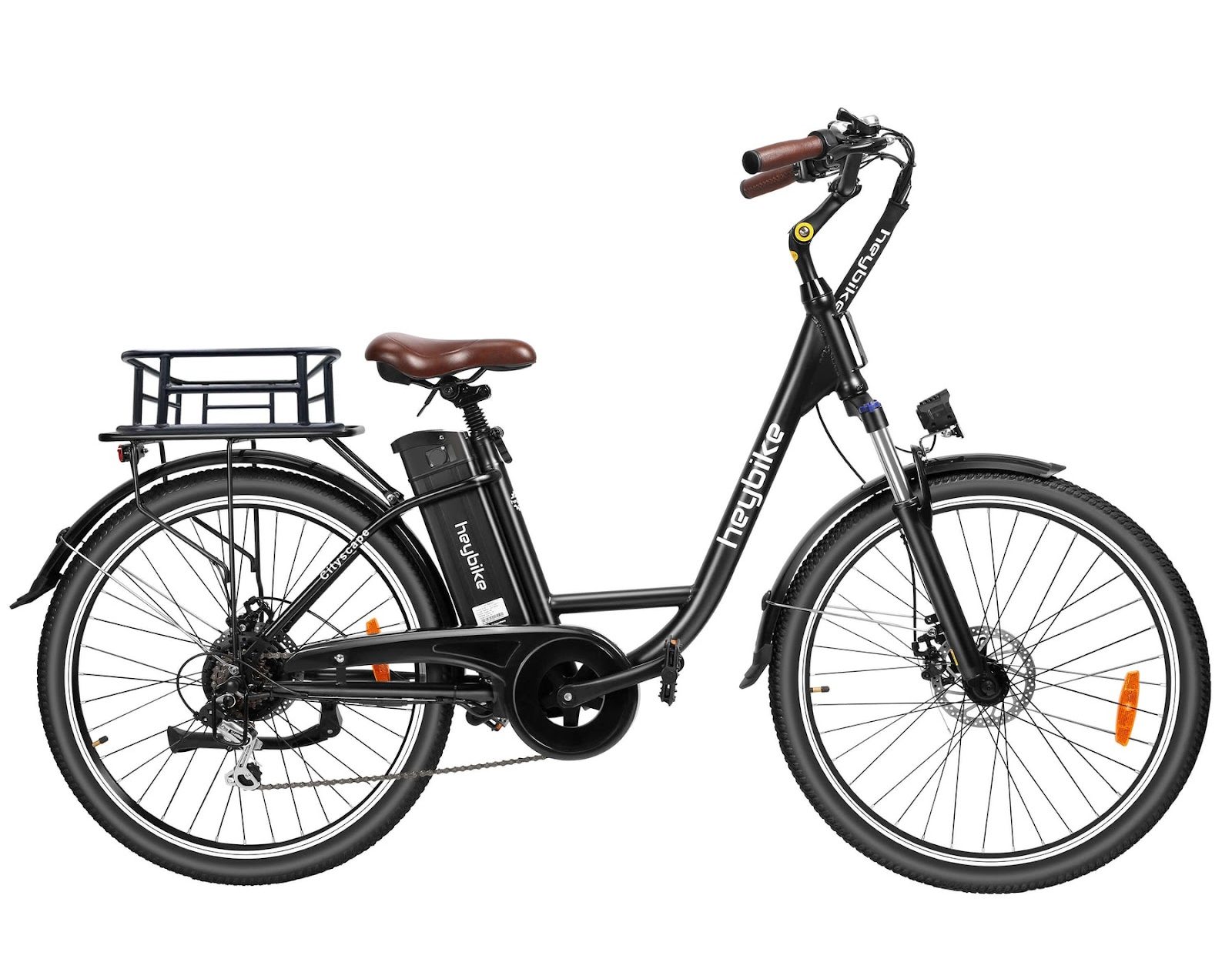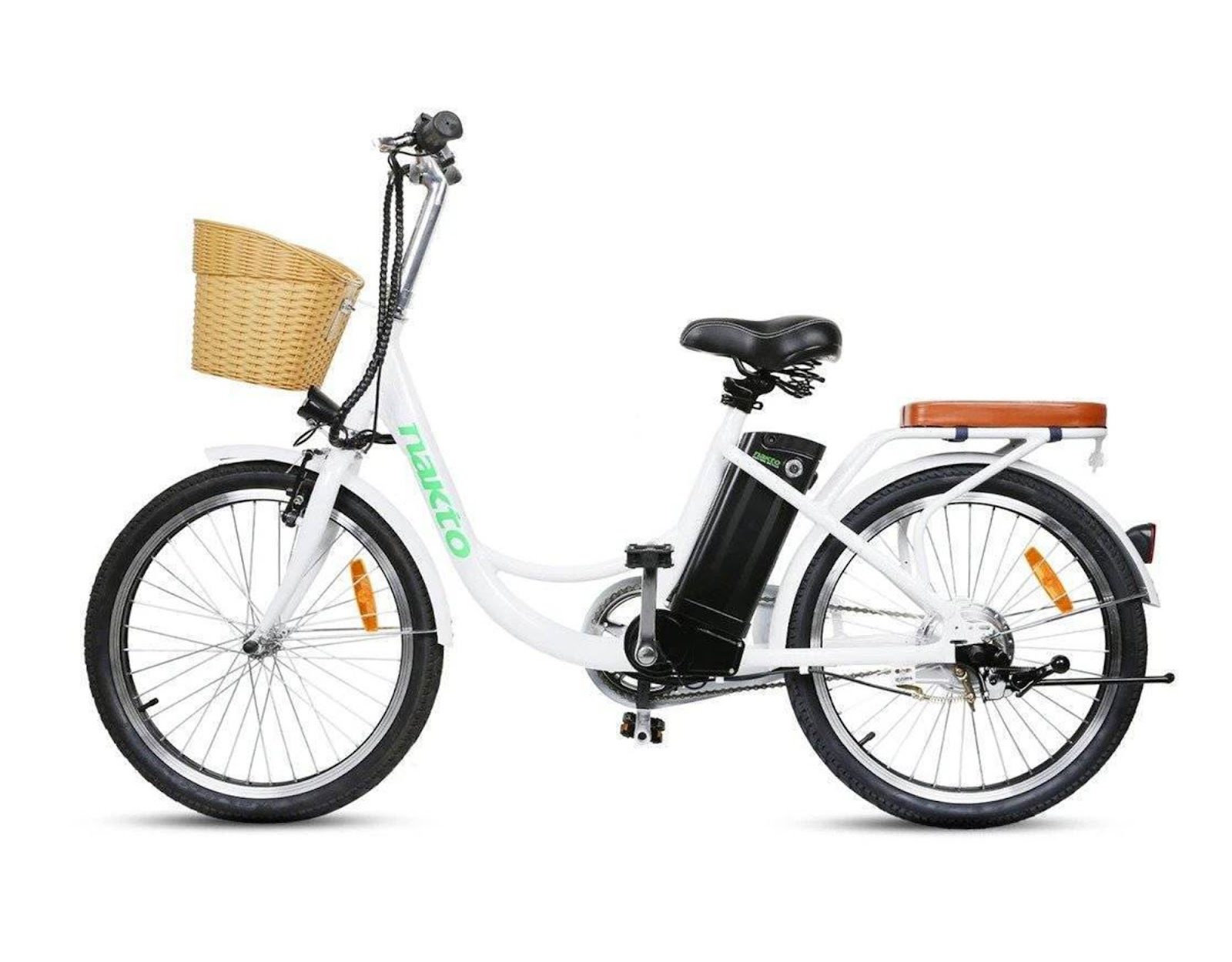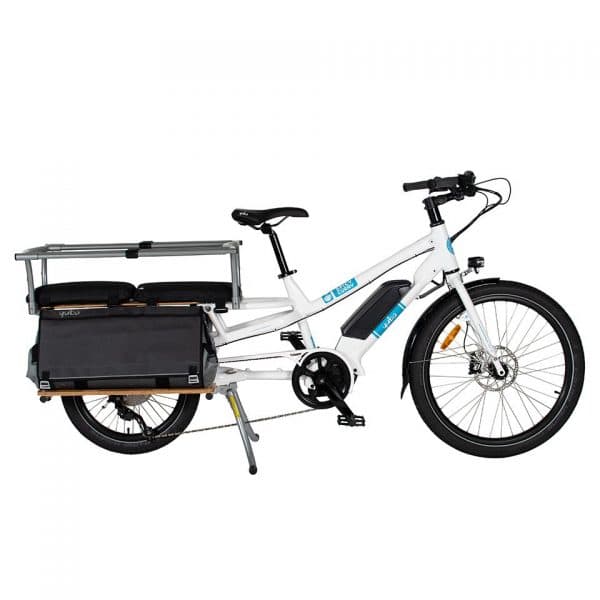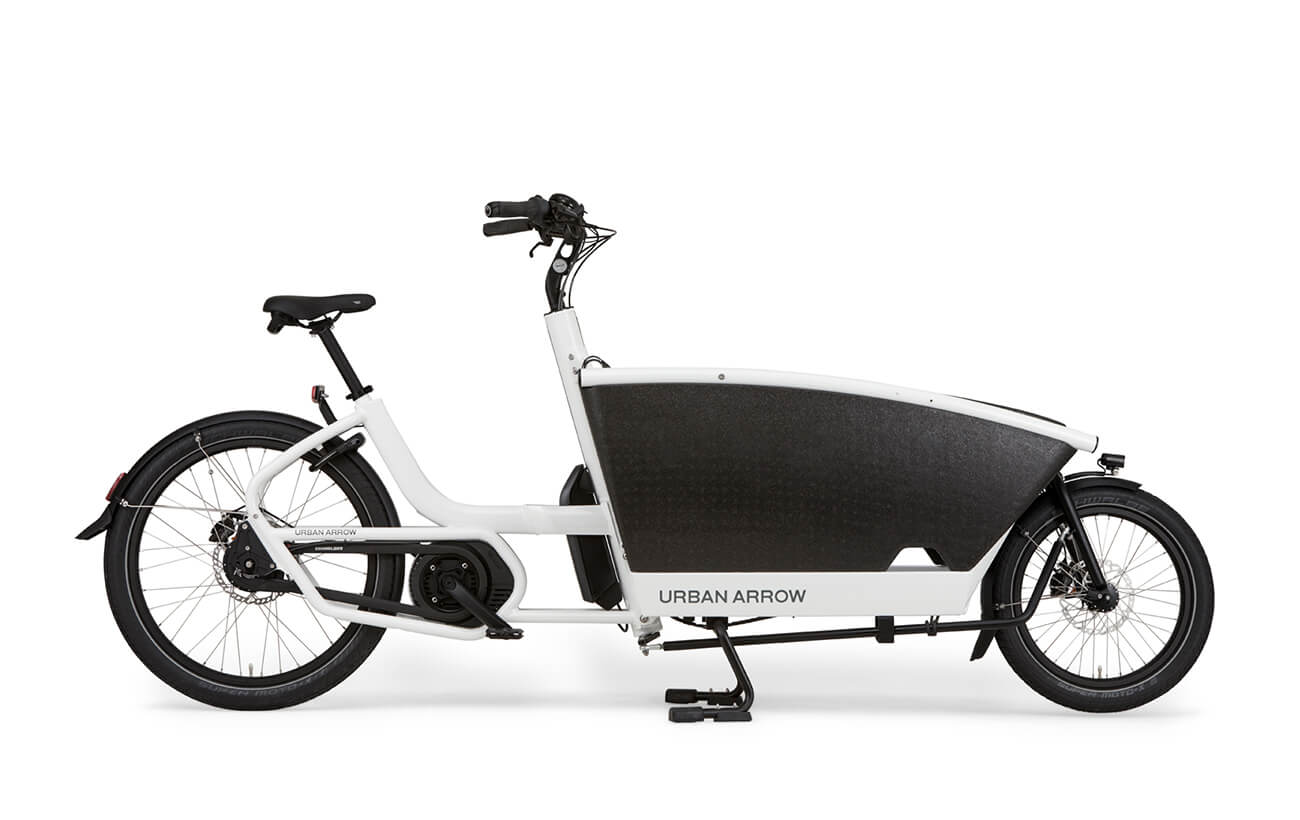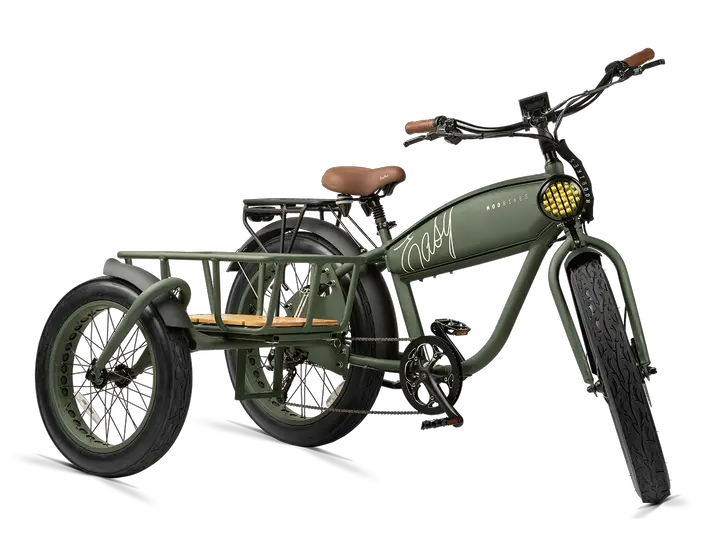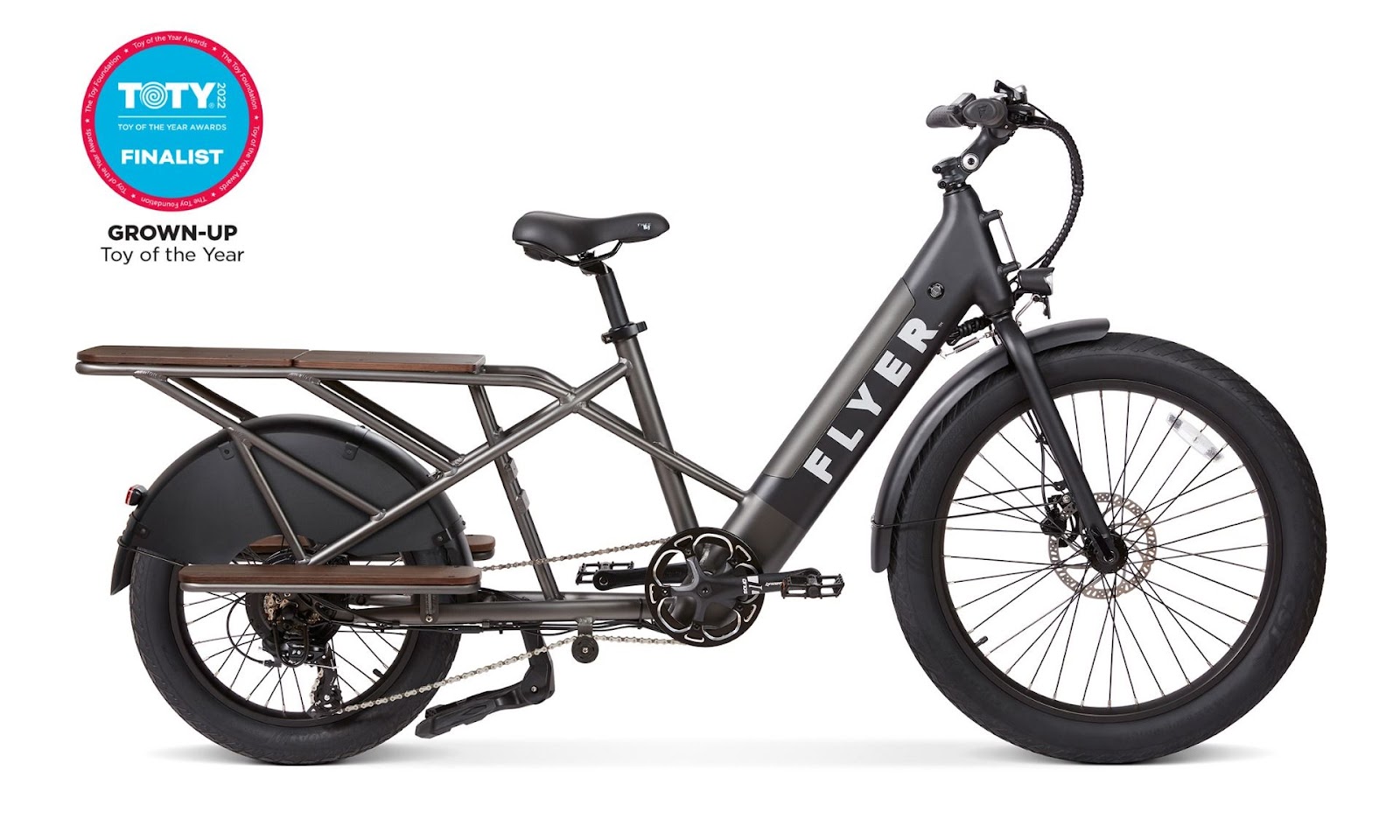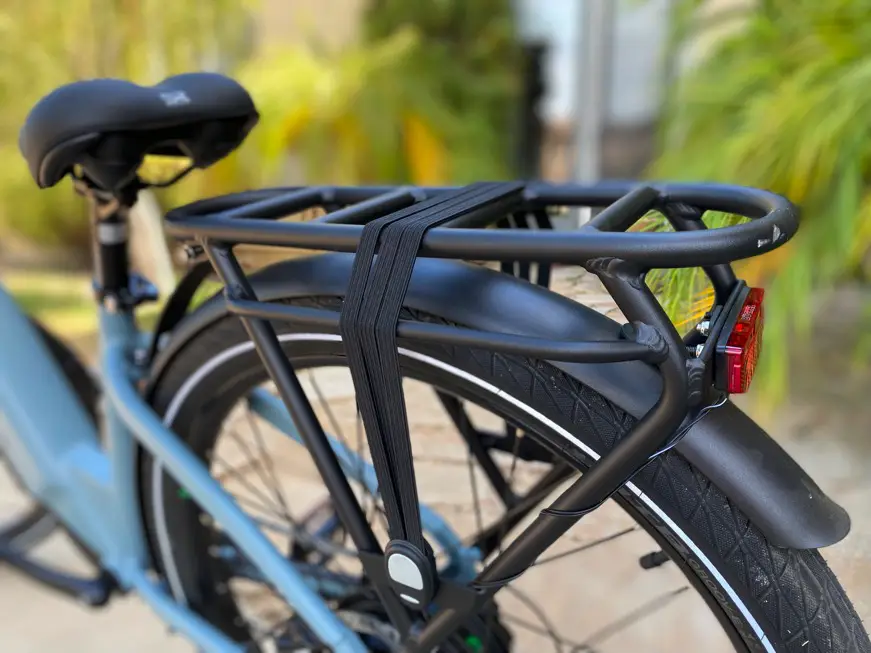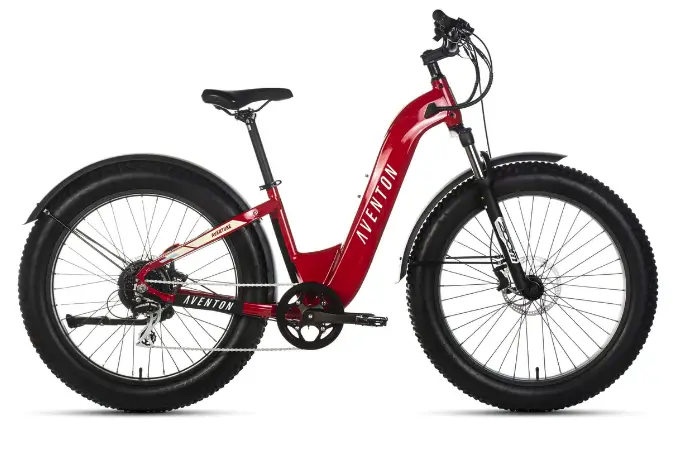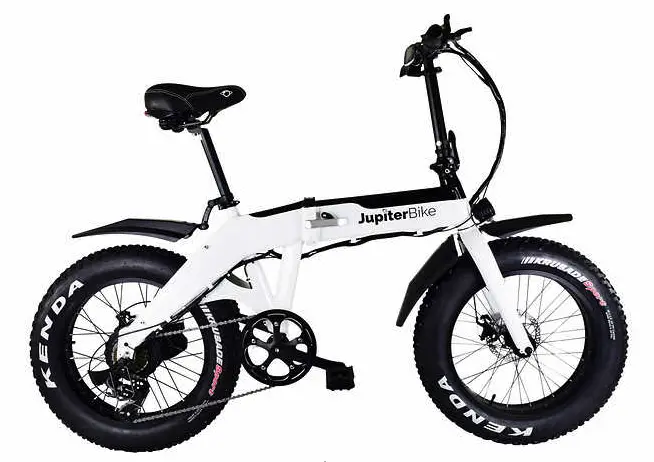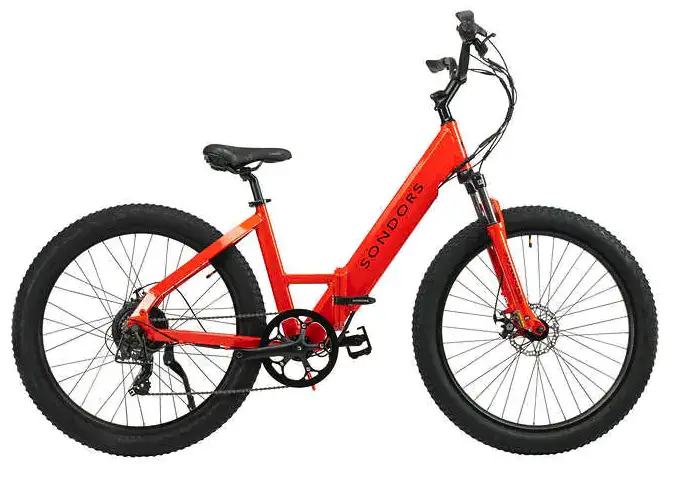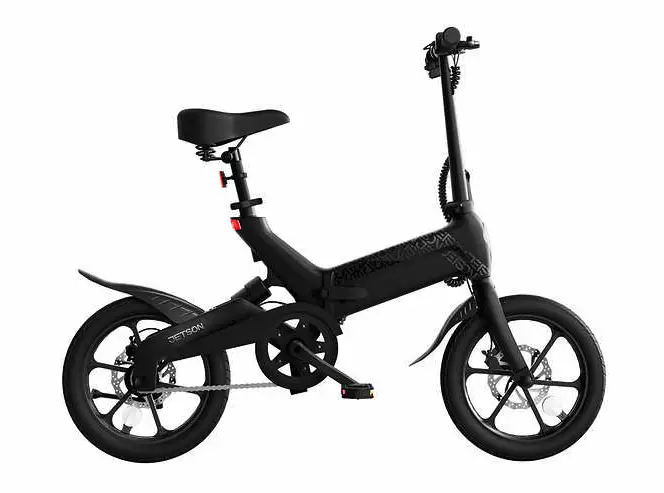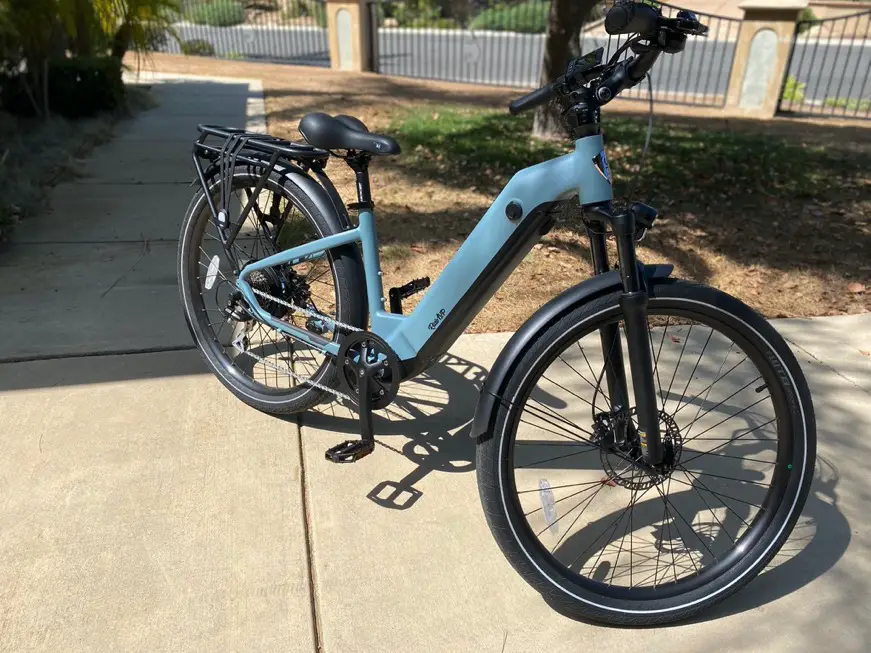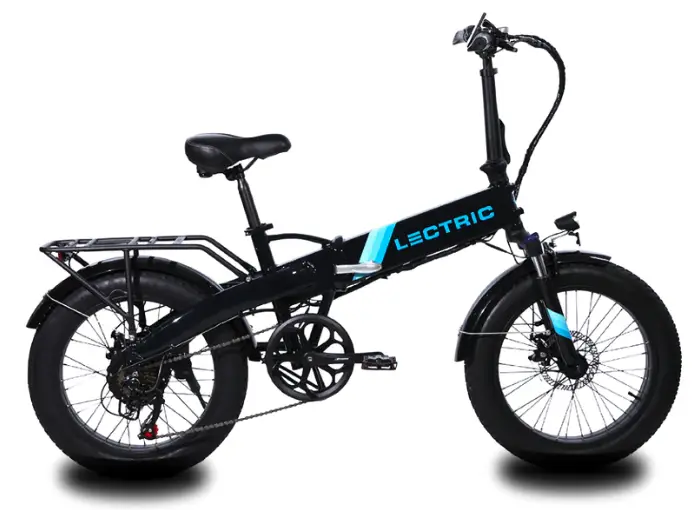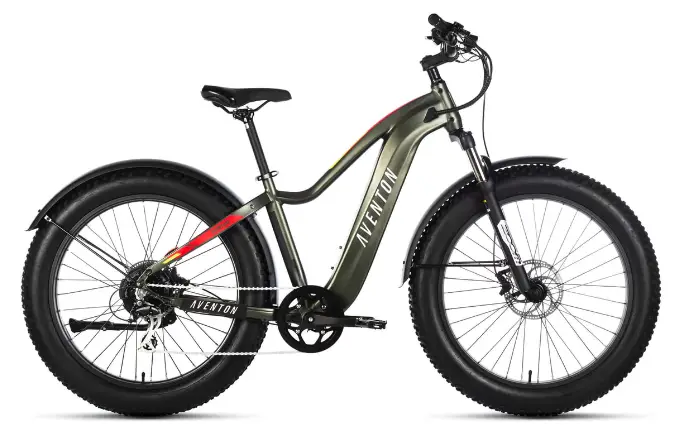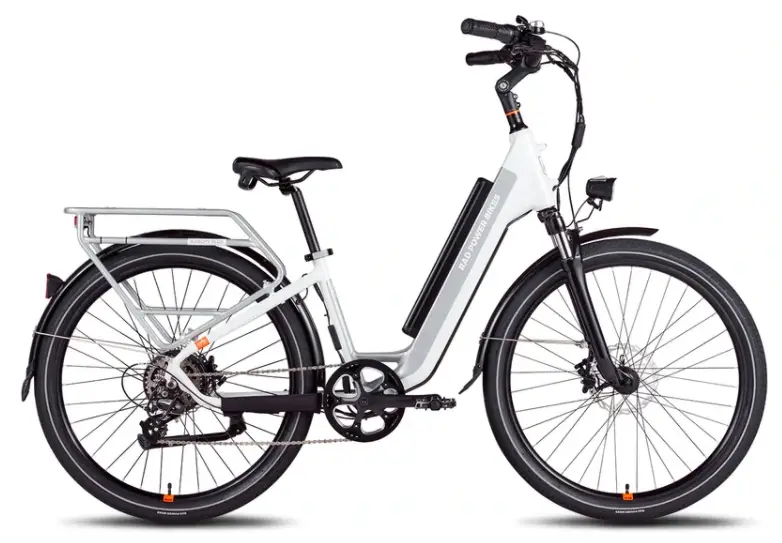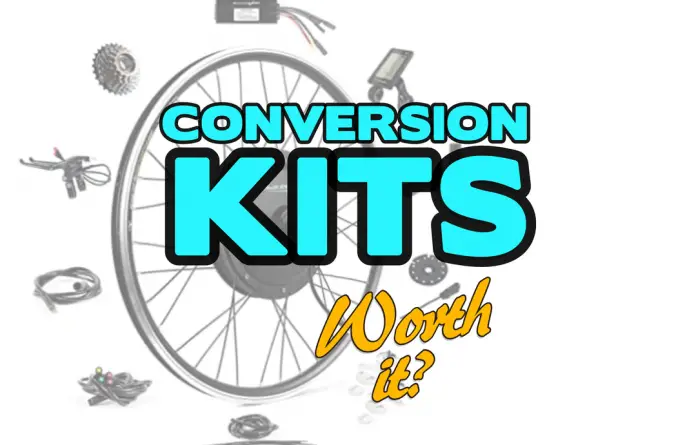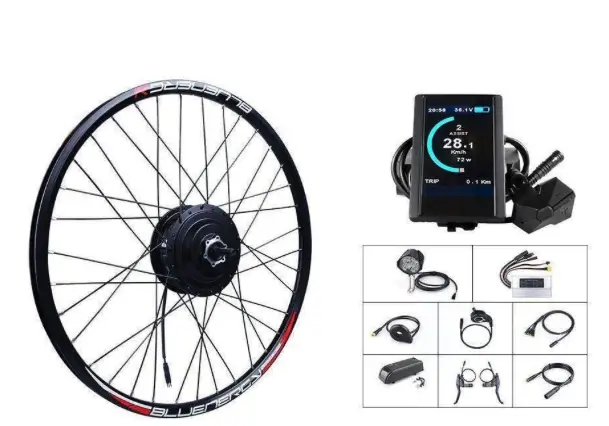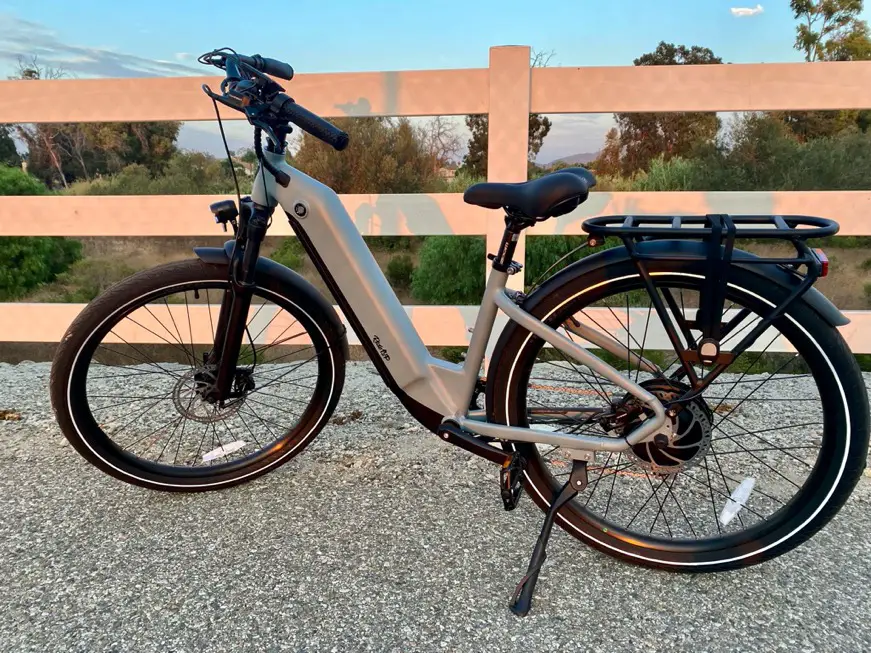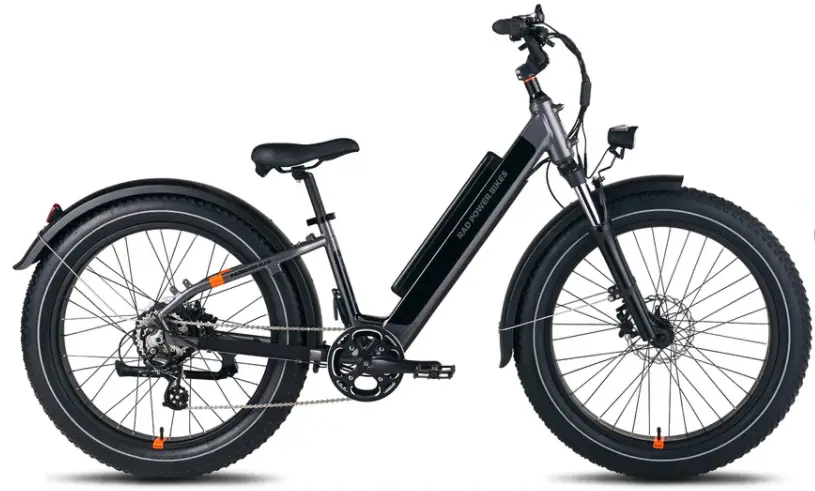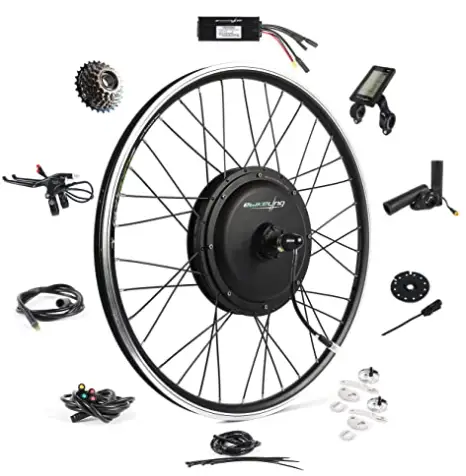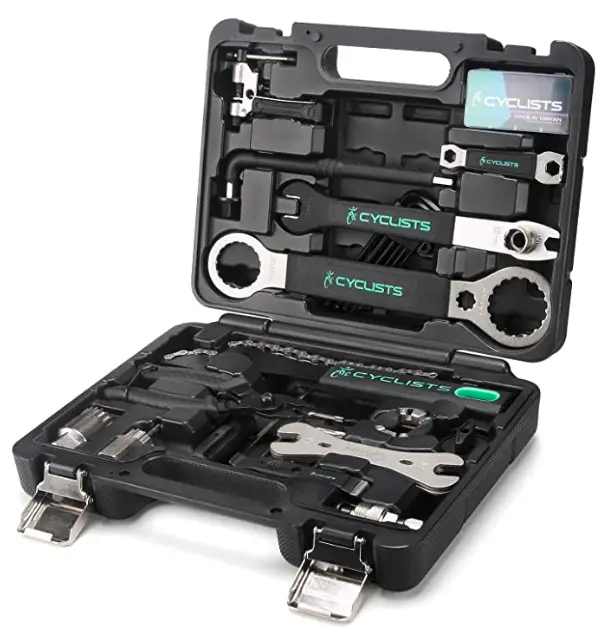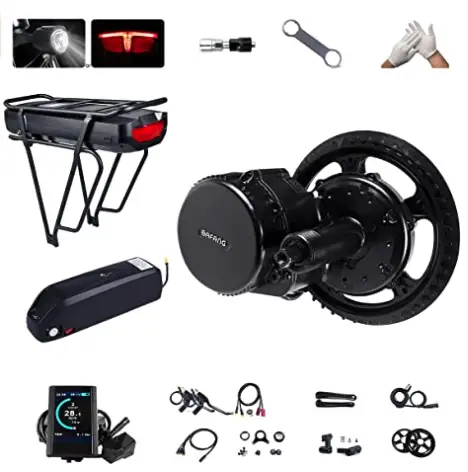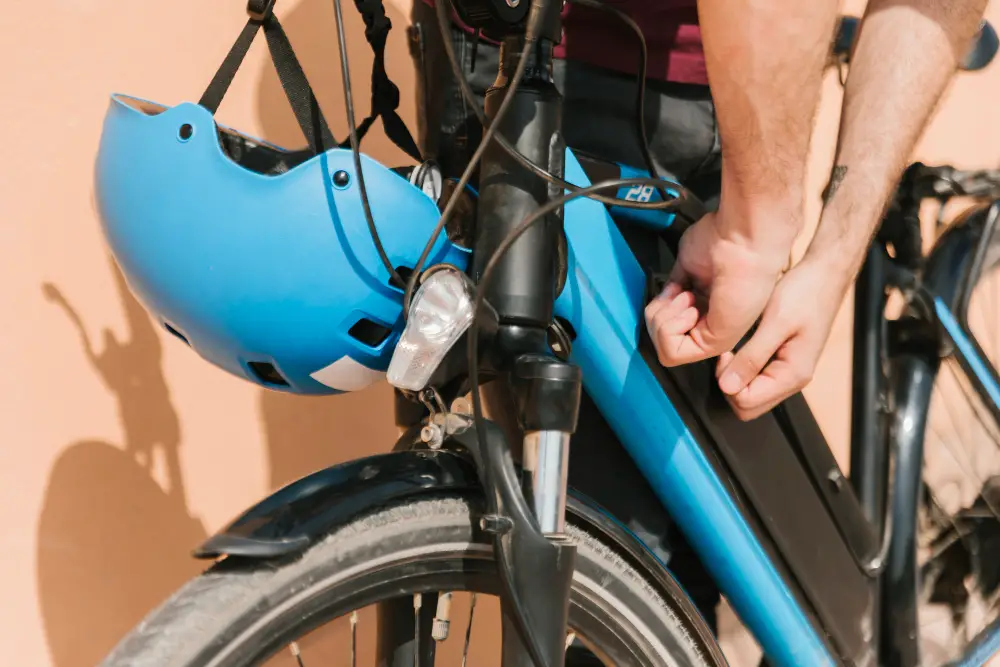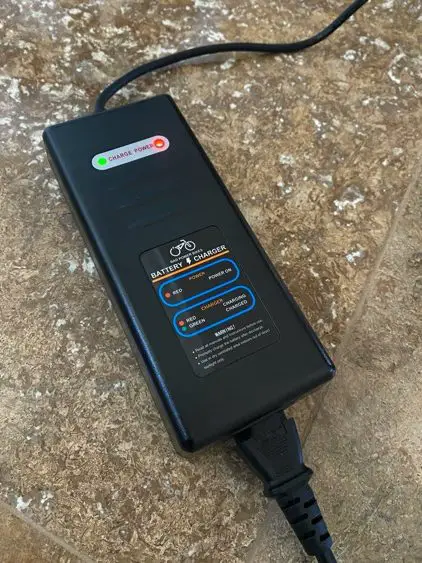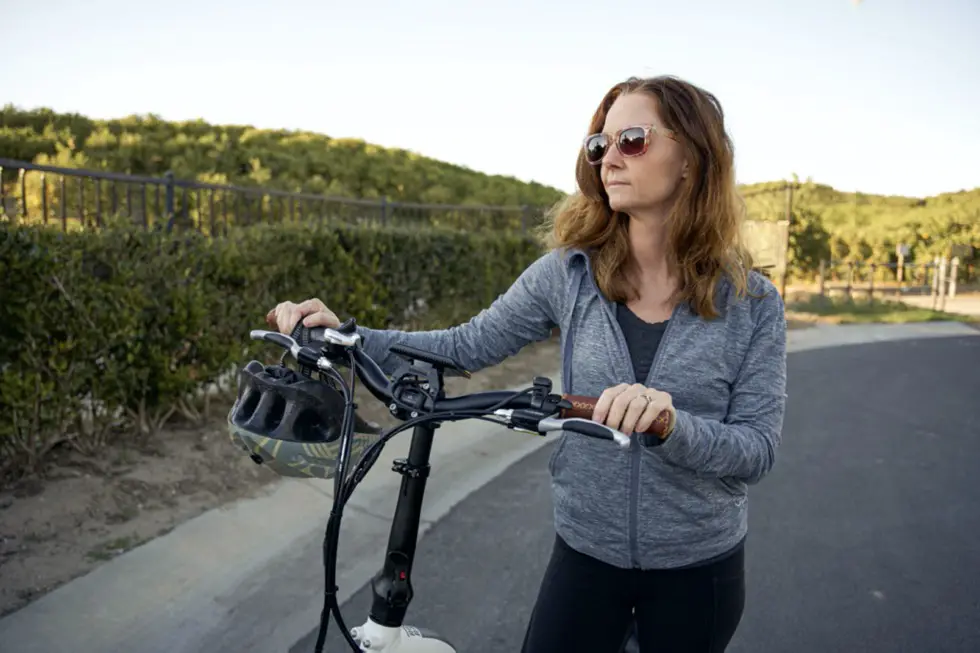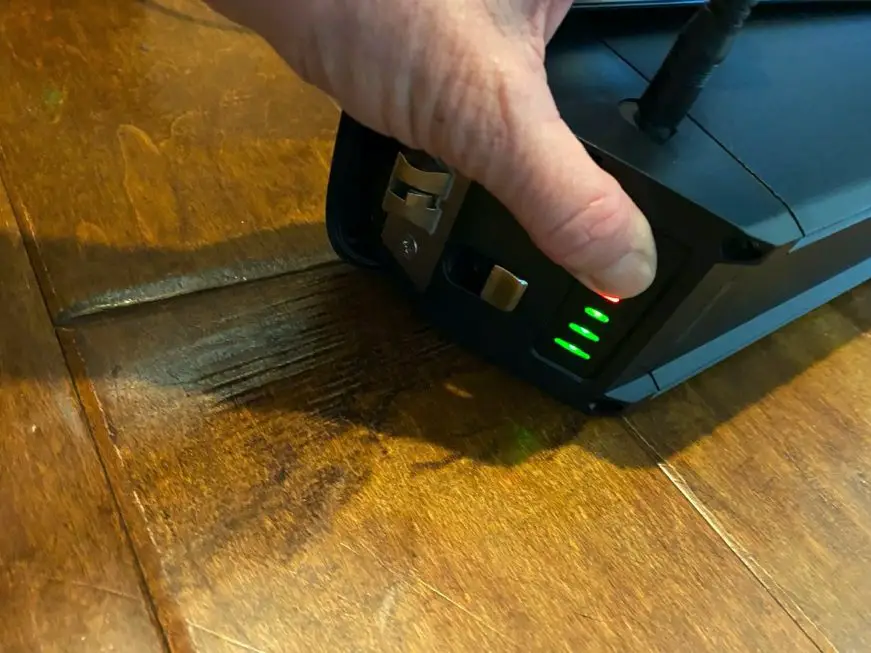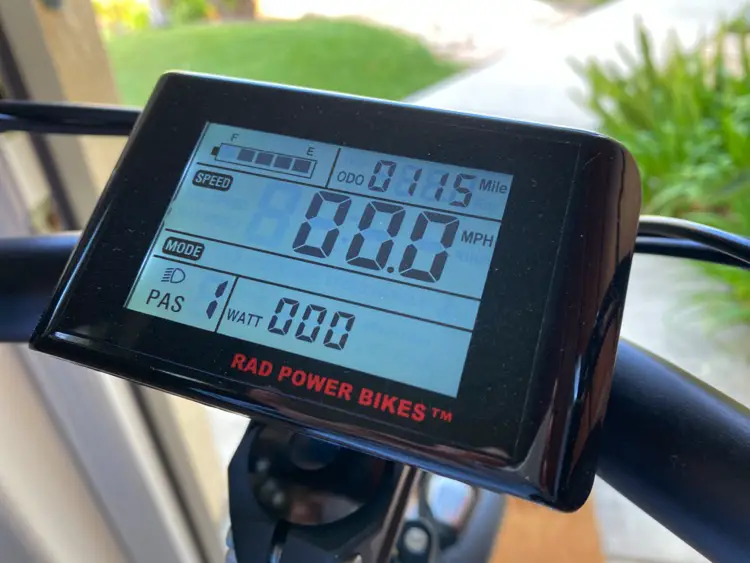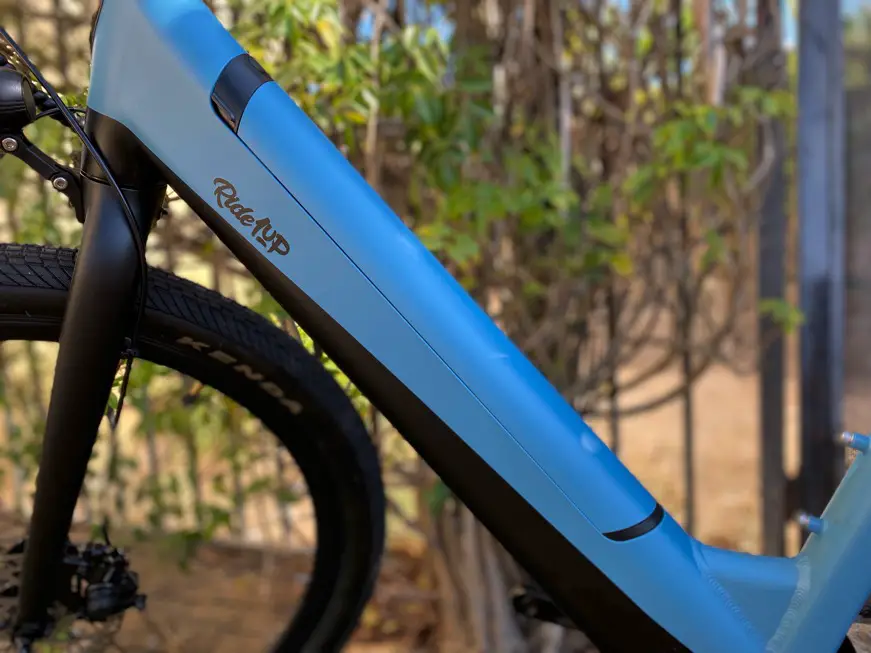E-bikes allow you to enjoy greater speeds and better navigate uneven terrain than your regular pedal bike. However, you might assume that mini e-bikes are only for teenagers and kids – but that’s not true! There are many affordable mini e-bikes for adults that are fun to ride and convenient.
The best mini electric bike for adults is the Swagtron Swagcycle EB-5 Electric Bike. It can achieve speeds of up to 15 mph (24 kph) on battery power alone. It’s compact, weighing only 37 lbs (17 kg), and has a carry handle for greater portability.
In this article, I’ll explore the Swagtron and other mini electric bikes for adults (all available on Amazon.com) that are affordable, powerful, and have many features to make riding around the city a pleasure.
Best Overall E-Bike, Winner: Swagtron Swagcycle EB05 Lightweight Aluminum Folding Electric Bike
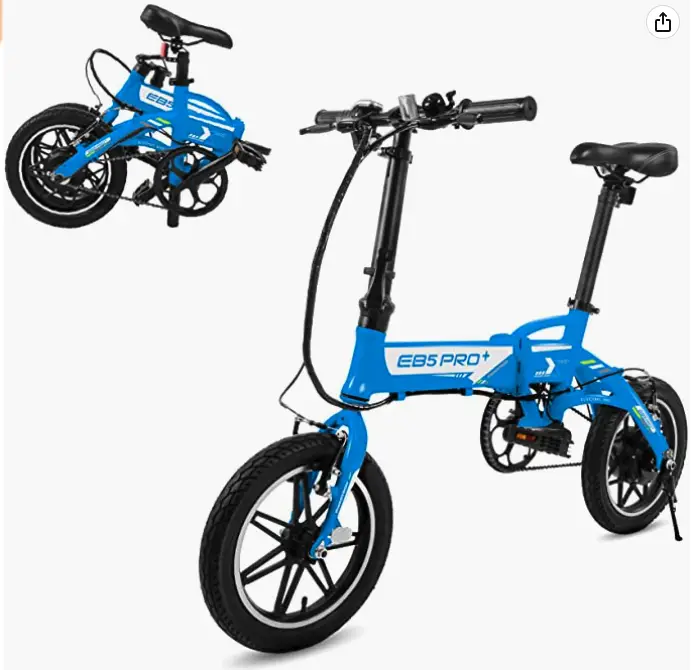
This mini electric bike comes fully assembled, so you can start riding it straight away. It’s aerodynamic and streamlined, giving you a top speed of 15.5 mph (24 kph) on one single battery charge. You can also purchase an extra battery to replace its current battery if you need to use it for a longer bike ride.
The Swagtron mini e-bike can be used as a pedal-only bike if you prefer, or you can use its pedal-to-go if you want a boost of power. Its 14-inch (35.5cm) tires are air-filled and provide a smooth ride even if you have to navigate bumpy roads during your daily commute.
Bottom Line: This e-bike gives you lots of power and comfort for a smooth ride wherever you go. Its 14-inch wheels are up to the task of helping you navigate a variety of terrain, which makes it versatile.
Pros
- Height-adjustable seat and handlebar: These allow you to customize the bike so that you feel more comfortable and in control.
- Foldable: You can fold up this mini e-bike in three easy steps, making it convenient when stored in the garage.
- Carry handle: It comes with a convenient carry handle so you can easily carry it with you.
Cons
- No front or rear lights provided: These are essential to purchase separately if you’re going to ride the bike in low-visibility conditions.
Product Features
| Color | White, Blue, Black |
| Wheel size | 14 inches (35.5cm) |
| Frame material | Aluminum |
| Weight | 37 lbs (17 kg) |
| Included items | Charger, Manual |
Best Overall E-bike, Runner Up: Jetson Bolt Adult Folding Electric Ride
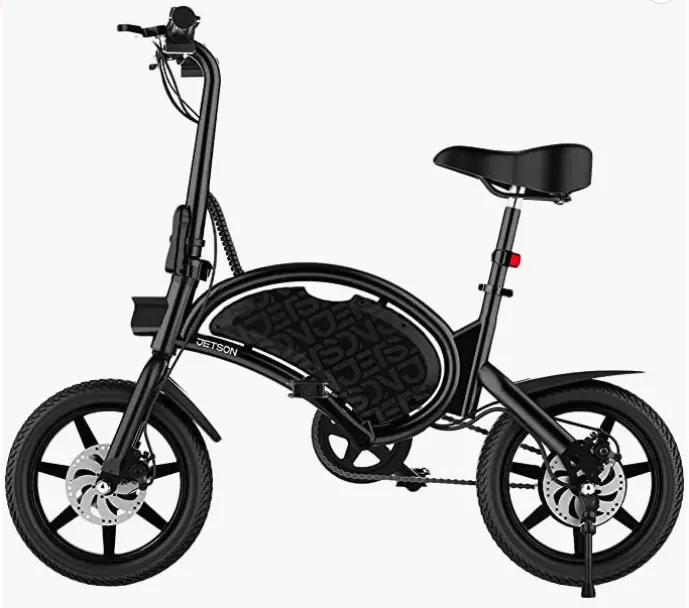
If you want an e-bike that allows you to ride around the city on a full charge and stay quiet, you’ll love this Jetson Bolt e-bike. It has a rechargeable lithium-ion battery for increased ease of use and a 240-watt motor that is strong yet doesn’t make a lot of noise. Check out my full review of the Jetson Bolt.
This e-bike enables you to ride around the city up to a distance of 15 miles (24km ) on a single battery charge. It comes with a twist throttle and cruise control for increased comfort during your ride.
Bottom Line: This Jetson Bolt mini e-bike has all the features to keep you safe and comfortable. The bike’s frame is lightweight, as it’s constructed out of aluminum alloy. Although light, it can tolerate up to 250 lbs (113kg) in weight.
Pros
- Collapsible handlebar: This makes it easy to store the bike under your desk at work.
- Backlight included: This increases visibility when riding in low-light conditions.
- Handlebar and seat adjustability: This enables you to find the right level of comfort.
Cons
- Heavy: Since it weighs 42 pounds (19kg), this bike is heavier than the previous model.
- No extra components: This e-bike doesn’t come with extra items like other e-bikes on the market.
Product Features
| Color | Black |
| Wheel size | 12 inches (30.4cm) or 14 inches (35.5cm) |
| Frame material | Aluminum |
| Weight | 42 lbs (19 kg) |
| Included items | N/A |
Best for Smooth Rides: Sailnovo Electric Bike
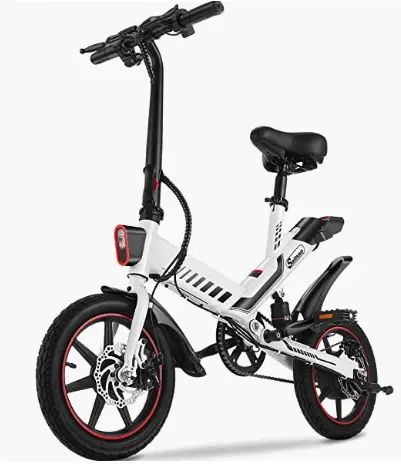
This striking bike has a 36V rechargeable lithium-ion battery on board that provides up to 18.5mph (30 kph) of speed. It has many features to make riding around the city more convenient, such as non-slip handlebars.
It has anti-shock tires, so you don’t have to worry about traveling over uneven or bumpy surfaces. And it’s equipped with an LCD speed and battery indicator, so you always know how you’re riding and when to charge your bike.
One of the best features of this Sailnovo bike is that it provides lots of customization. You can add a basket to the front of the bike and a kettle holder (like this one on Amazon) to hold various items you need on all your adventures.
Bottom Line: This e-bike is designed with greater comfort in mind, thanks to its attention to detail. You can customize it to make it even more user-friendly and fun to ride.
Pros
- Front lamp and tail lights: This electric bike has lights installed to keep you visible.
- Max slope of 15°: It can be used on roads with a maximum slope of 15°.
- Non-slip handlebars: This ensures a greater grip when weather conditions are poor.
- Foldable: The bike is foldable to make it portable.
Cons
- Not fully assembled: You need to install the pedals and saddle.
- Uncomfortable seat: The seat is quite hard.
- Not suitable for rainy days: It’s not waterproof.
Product Features
| Color | White, Blue, Black, or Orange |
| Wheel size | 14 inches (35.5cm) |
| Frame material | Aluminum |
| Weight | 46.3 lbs (21kg) |
| Included items | User Manual, Charger, Tool |
Best for Rainy Days: Ancheer Electric Bike
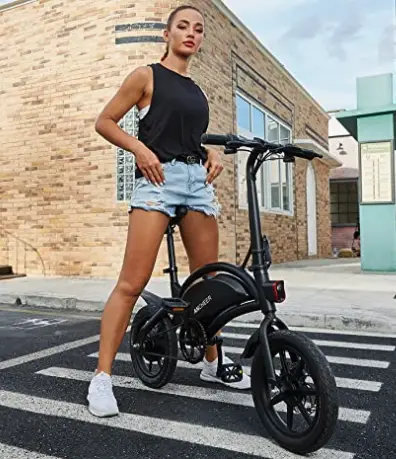
Not all e-bikes can be used when it’s raining. Some don’t have a waterproof shell to maintain their good condition. This e-bike has an IPX5 waterproof range that protects your bike on rainy days.
It’s equipped with a 500W high-speed brushless motor that reaches up to 20 mph (32 kph). And with its 48V lithium-ion battery, this bike allows you to ride up to 20 miles (32 km) on a single charge.
The e-bike also has dual disc brakes that ensure your safety, even when riding faster. Both its front and rear disc brakes make stopping smooth and safe, even if you’re riding at high speed.
Bottom Line: This is a great e-bike if you want durability, speed, and waterproof features.
Pros
- High load capacity: This electric bike can tolerate a weight capacity of up to 265 lbs (120 kg).
- Battery protection: The battery is short-circuit protected and offers overcharge protection.
- Anti-slip wheels: The 14-inch (35.5cm) rubber wheels are resistant to slippage.
- Cruise control: You can engage cruise control by twisting the throttle for eight seconds and pressing the switch.
Cons
- Lack of shock absorption: This can make navigating difficult terrain uncomfortable.
Product Features
| Color | White or Black |
| Wheel size | 14 inches (35.5cm) |
| Frame material | Steel |
| Weight | 39.7 lbs (18 kg) |
| Included items | N/A |
Best for Comfort: DYU D3F 14 in Folding Electric Bicycle
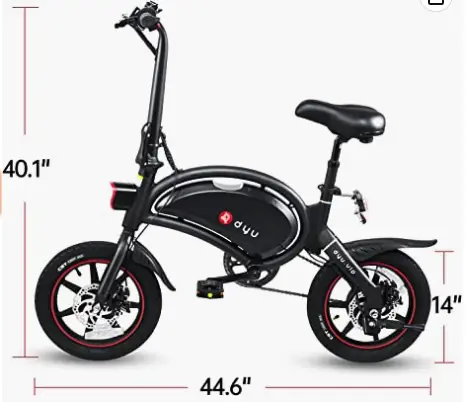
This DYU bike comes with a 250-watt brushless motor that enables you to reach a speed of up to 15.5mph (24 kph). You can ride up to 45 miles (73 km) when you engage its electric-assist mode.
It comes in three modes: e-bike, normal bike, and assisted bicycle. This means you can enhance your speed, such as with the throttle in electric-assist mode, when required. You can also use all three modes simultaneously.
This e-bike has a frame made of high-strength carbon steel that provides excellent shock absorption. Its magnesium alloy wheels are resistant to skidding, so you’ll be able to use it on uneven terrain.
Bottom Line: If you want an e-bike built for comfort, this DYU bike has many features for a more comfortable ride.
Pros
- 100% foldable frame: The frame is lightweight and can be folded so that you can travel with the bike.
- Bright LED headlamp: This increases your visibility during night rides.
- Bell included: It comes with a bell if you need it when riding in low-visibility or other dangerous conditions.
Cons
- Not fully assembled: This e-bike doesn’t come fully assembled, but it’s easy to put it together.
Product Features
| Color | Black |
| Wheel size | 14 inches (35.5 cm) |
| Frame material | Carbon steel |
| Weight | 42 lbs (19 kg) |
| Included items | Bell |
Best Trail Electric Bike: EUY Folding Electric City Commuter Bike For Adults
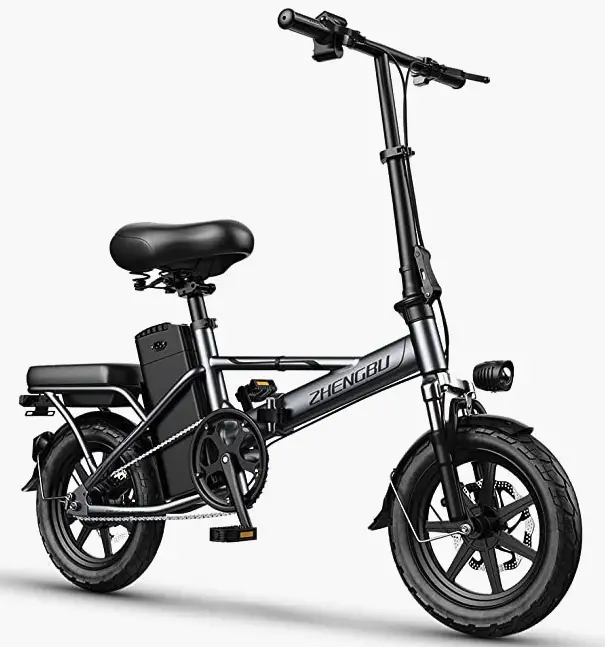
This 14-inch e-bike has a 500W motor and 18Ah lithium-ion battery on board, both of which help you navigate roads faster. You’ll be able to hit speeds of up to 21 mph (34 kph) and travel up to 60 miles (96.5km) from home when using the bike’s electric-assist mode.
Its throttle allows you to get a burst of speed when you need it, such as when you need to move quickly through traffic.
You can also climb 30° inclines, so it’s perfect for tackling hills. And if you need to head out onto a trail, this EUY bike will make your cycling experience much better because it has a front fork constructed out of high-strength carbon steel and contains shock absorption to make your ride comfortable.
Bottom Line: If you want to ride off the beaten track, this electric bike has features to make it an enjoyable experience.
Pros
- Adjustable: It has an adjustable seat and a removable battery to accommodate your needs.
- LED 3-speed smart meter button: This makes it easy to choose different riding modes – e-bike/assisted bike/normal bike.
- Headlight and rear light included: These will make you more visible on the road while giving you greater visibility.
Cons
- Components can become rusty: Any metal on the bike can become rusty when exposed to rain.
- It doesn’t come fully assembled: You will have to take some time to put it together.
Product Features
| Color | Grey or Orange |
| Wheel size | 14 inches (35.5cm) |
| Frame material | Carbon Steel |
| Weight | 50 lbs (23 kg) |
| Included items | Charger |
Best Trail Bike Alternative: Xprit Folding Electric Bike
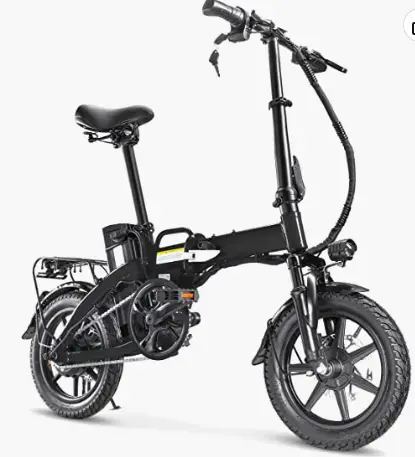
This electric bike has a quick speed boost, allowing you to reach speeds of up to 15.5mph (25 kph) within seconds, which helps during traffic. But you can also use it off the beaten track, as a single battery charge enables you to reach distances of 27.9 miles (45 km).
With its front suspension fork and dual disc, this e-bike gives you a safe yet comfortable riding experience. It also has an LCD display that monitors your battery life, so you stay ahead of charging it.
Bottom Line: This e-bike can be used on different terrain and trails, so you can extend your adventures. It’s also a little more affordable than the previous e-bike on our list.
Pros
- High-beam LED headlight: This ensures greater visibility.
- Portable: The light aluminum alloy frame is easy to carry around.
- Adjustable seat and handlebar: This ensures you get the perfect position to ride.
- Rear luggage rack: This helps you transport heavy items.
Cons
- Difficult assembly: This e-bike isn’t easy to put together, especially for beginners.
Product Features
| Color | Black, Blue, or White |
| Wheel size | 14 inches (35.5 cm) |
| Frame material | Aluminum |
| Weight | 44 lbs (20 kg) |
| Included items | User Manual, E-bike Accessory Kit, Charger |
Best Value for Money: ENGWE Folding Electric Bikes for Adults
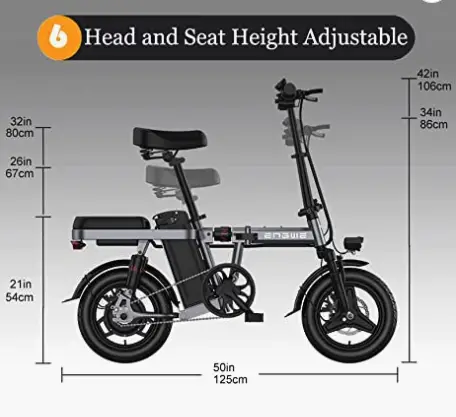
If you want a mini bike that gives you the versatility to ride on a variety of terrain, this ENGWE folding bike is worth checking out. It’s small and compact, with its folded size being 29 x 22 x 29.5 inches (73.6 x 55.88 x 74.93 cm). You can fold it up in mere seconds!
This e-bike has a 48V 350W high-power brushless motor that can reach speeds of up to 19.2mph (30.8 kph). It has three riding modes – pedal, power-assist, and pure electric – so you can choose the mode that feels most comfortable.
With its multiple shock absorbers, this electric bike will ensure bumpy roads don’t get in your way. Additionally, its 14-inch (35.5 cm) rubber tires are resistant to tears, punctures, wear and tear, and slippage.
Bottom Line: While you might primarily use your e-bike for your daily commute, this bike will give you the chance to navigate other terrains on weekends. It’s also more affordable than many other e-bikes on the market.
Pros
- Maximum 22-mile (35.4 km) mileage: You can travel up to 22 miles (35.4 km) on a single charge.
- Four shock absorbers: This e-bike has front-fork, center-shock, rear wheel, and saddle shock absorbers.
- Front and rear double-disc brakes: These disc brakes keep you safe, with a braking distance of about 5.9 feet (2 m).
Cons
- No rear light: The e-bike doesn’t have a rear light included.
- Squealing brakes: You might sometimes experience squealing brakes.
Product Features
| Color | Silver |
| Wheel size | 14 inches (35.5 cm) |
| Frame material | Carbon steel |
| Weight | 61 lbs (28 kg) |
| Included items | Bell, Toolkit, Mudguard, Kickstand |
Best for Speed: Swagtron Swagcycle EB-7 Elite Plus
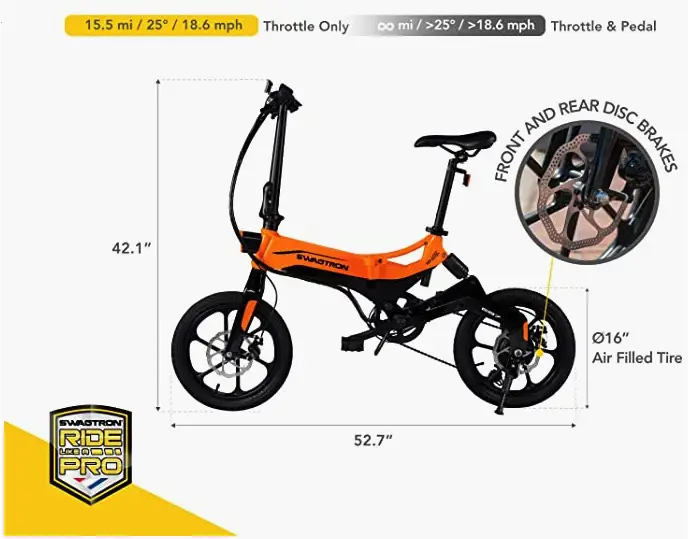
This Swagtron electric bike offers seven speeds so you can navigate tricky terrain, such as hills, without a problem. It contains 23% more power than previous Swagtron models and a throttle-only range of up to 18.6 miles (30km) on a single battery charge.
If inclines are a problem, this Swagtron bike will make them easy to navigate as it can tolerate 25° inclines. Best of all, you won’t have to worry about its charging ability. While some e-bike batteries need around six hours to charge, this one can reach a full charge within three or four hours.
Bottom Line: With its speed and quick charging times, this Swagtron e-bike is built for fast riding.
Pros
- Protected battery: It has a compartment that can be locked, keeping your e-bike battery protected from water and dust.
- Enhanced rear suspension: This ensures you can tolerate rougher terrain easily.
- Removable battery: You can swap your current battery with a new one (sold separately) for longer adventures.
- Carry handle included: You can easily carry the e-bike and store it.
Cons
- Difficult to carry when folded: This can be frustrating if you’re traveling with your e-bike.
Product Features
| Color | Orange |
| Wheel size | 16 inches (40.64 cm) |
| Frame material | Aluminum |
| Weight | 42.3 lbs (19.2 kg) |
| Included items | User Manual, Charger |
Best for Daily Commute: ONEBOT S7 Aviation Electric Bike
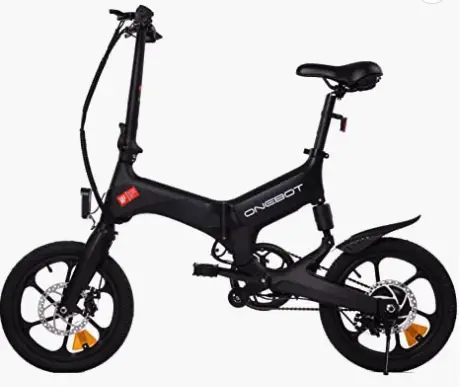
With three ride modes at your disposal, this e-bike gives you the chance to have the most comfortable ride. You can travel up to 30 miles (50 km) on a single battery charge without a problem.
One of its best features is a detailed LCD display. This feature provides data pertaining to your distance, speed, pedal-assist level, and battery life. And it will help you stay on top of your riding style and bike.
This e-bike combines speed with comfort. It has a light magnesium frame that’s lighter than aluminum while being resistant to corrosion and other damage. This makes the bike durable and increases its lifespan.
Bottom Line: This mini e-bike is a solid choice as it ticks all the right boxes, giving you the essential e-bike features you need.
Pros
- Secure battery: It has a hidden lithium-ion battery to keep it safe.
- Quick fold-up: It folds up within mere seconds, and it’s compact, so you can store it under your desk.
- Accessories included: When ordered from Amazon.com, it has front and rear fenders, a charger, and a bike pump included.
- Lightweight: This e-bike weighs 51 lbs (23 kg).
Cons
- Glossy appearance: This e-bike has a glossy surface that can easily show scratches.
Product Features
| Color | Black, Dark grey, Light grey |
| Wheel size | 16 inches (35.5 cm) |
| Frame material | Magnesium |
| Weight | 51 lbs (23 kg) |
| Included items | Charger, Mudguard |
Best for Riding Uphill: Vivi Folding Electric Bike

Although this Vivi electric bike is small and portable, you can ride it up to 65 miles (98 km) in electric-assist mode. This is much more than the maximum distances you’ll be able to achieve with some other small e-bikes on the market. It also has a 48V, 20Ah removable battery.
This bike has three riding modes: electric assist, pedal riding, and electric mode.
It can be used on 30° inclines, which is also more than what you’ll experience with many other e-bikes. So, if your daily commute has many uphill terrains, this e-bike will make your rides more enjoyable.
Bottom Line: With its steeper incline-climbing ability, this Vivi mini e-bike opens up your terrain options.
Pros
- Quick charging time: It can charge within four to six hours.
- Front and rear double-shock absorption: You can ride it on bumpy or uneven terrain without a hassle.
- Enlarged seat cushion: To make your long trips more comfortable, this e-bike comes with a large seat cushion.
Cons
- Heavy: This e-bike is slightly heavier than other small e-bikes on the market.
Product Features
| Color | Black |
| Wheel size | 14 inches (35.5 cm) |
| Frame material | Aluminum |
| Weight | 57 lbs (26 kg) |
| Included items | Toolkit |
Best for Long Distances: Etek Bolt Mini E-Bike for Adults
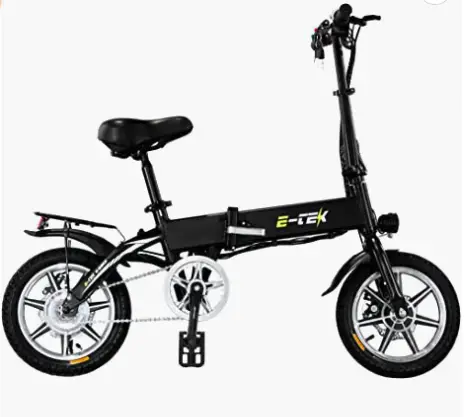
This Etek e-bike goes the distance. Thanks to its battery that contains larger cells, you can reach a distance of up to 37 miles (60 km) when cycling in pedal-assist mode. You can also reach up to speeds of 20mph (32 kph).
When you need to brake, the e-bike helps you come to a smooth stop, thanks to its disc brakes. It’s equipped with a 250-watt hub-drive motor. Although it can be fast, it’s lightweight to control, thanks to its aluminum alloy frame.
Bottom Line: If you need to travel longer distances, this e-bike will help you get there without a problem.
Pros
- Bright LED lights: To keep you safe when riding at night, this e-bike has bright lights included.
- Large cargo rack: The bike comes with a large cargo rack that increases your storage space.
- Collapsible pedals: This makes them easy to use and store.
- Adjustable: It comes with an adjustable seat and handlebars.
Cons
- Not fully assembled: This e-bike doesn’t come fully assembled, so you will need to spend some time putting it together.
Product Features
| Color | White, Black, Red |
| Wheel size | 14 inches (35.5 cm) |
| Frame material | Aluminum |
| Weight | N/A |
| Included items | Mudguard, Cargo Rack |
Factors To Consider When Buying a Mini Electric Bike for Adults
When shopping for a mini electric bike for adults, there are some important things to consider before making your purchase. Let’s take a look at them and see what e-bike models on our list fulfill these requirements the best.
Weight
| Swagtron Swagcycle EB05 Lightweight Aluminum Folding Electric Bike | 37 lbs (17 kg) |
| Jetson Bolt Adult Folding Electric Ride | 42 lbs (19 kg) |
| Sailnovo Electric Bike | 46.3 lbs (21 kg) |
| Ancheer Electric Bike | 39.7 lbs (18 kg) |
| DYU D3F 14 in Folding Electric Bicycle | 42 lbs (19 kg) |
| EUY Folding Electric City Commuter Bike For Adults | 50 lbs (23 kg) |
| ENGWE Folding Electric Bikes for Adults | 61 lbs (28 kg) |
| Swagtron Swagcycle EB-7 Elite Plus | 42.3 lbs (19 kg) |
| Xprit Folding Electric Bike | 44 lbs (20 kg) |
| ONEBOT S7 Aviation Electric Bike | 51 lbs (23 kg) |
| Vivi Folding Electric Bike | 57 lbs (26 kg) |
| Etek Bolt Mini E-Bike for Adults | N/A |
Winner: Swagtron Swagcycle EB05 Lightweight Aluminum Folding Electric Bike
Mini e-bikes should be small and compact, as well as easy to carry around, otherwise, they’re not as portable or user-friendly as they should be. This Swagtron Swagcycle e-bike weighs the lowest of all the bikes on our list. For increased convenience, it also has a carry handle.
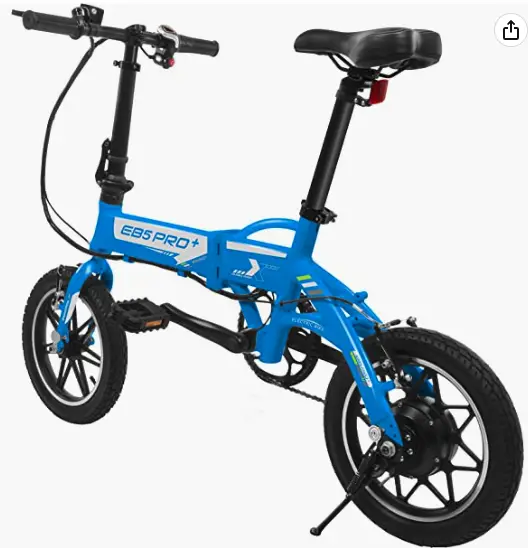
Distance
| Swagtron Swagcycle EB05 Lightweight Aluminum Folding Electric Bike | 15.5 mph (24 kph) |
| Jetson Bolt Adult Folding Electric Ride | 15 mph (24 kph) |
| Sailnovo Electric Bike | 18.5 mph (30 kph) |
| Ancheer Electric Bike | 20 mph (32 kph) |
| DYU D3F 14 in Folding Electric Bicycle | 15.5 mph (24 kph) |
| EUY Folding Electric City Commuter Bike For Adults | 21 mph (34 kph) |
| ENGWE Folding Electric Bikes for Adults | 19.2 mph (30.8 kph) |
| Swagtron Swagcycle EB-7 Elite Plus | 18.6 mph (30 kph) |
| Xprit Folding Electric Bike | 15.5mph (24 kph) |
| ONEBOT S7 Aviation Electric Bike | N/A |
| Vivi Folding Electric Bike | 20mph (32 kph) |
| Etek Bolt Mini E-Bike for Adults | 20mph (32 kph) |
Winner: EUY Folding Mini Electric Bike For Adults
If you’re looking to reach higher speeds with your mini e-bike, you should choose the EUY folding bike. It can reach a top speed of 21 mph (34 kph), which is faster than the other bikes on our list. It also has shockproof tires so you can navigate bumps in the road without discomfort.
Accessories Included
| Swagtron Swagcycle EB05 Lightweight Aluminum Folding Electric Bike | Charger, User Manual |
| Jetson Bolt Adult Folding Electric Ride | N/A |
| Sailnovo Electric Bike | User Manual, Charger, Tool |
| Ancheer Electric Bike | N/A |
| DYU D3F 14 in Folding Electric Bicycle | Bell |
| EUY Folding Electric City Commuter Bike For Adults | Charger |
| ENGWE Folding Electric Bikes for Adults | Bell, Toolkit, Mudguard, Kickstand |
| Swagtron Swagcycle EB-7 Elite Plus | User Manual, Charger |
| Xprit Folding Electric Bike | User Manual, E-bike Accessory Kit, Charger |
| ONEBOT S7 Aviation Electric Bike | Charger, Mudguard |
| Vivi Folding Electric Bike | Toolkit |
| Etek Bolt Mini E-Bike for Adults | Mudguard, Cargo Rack |
Winner: ENGWE Folding Electric Bikes for Adults
Although most of the mini e-bikes on our list have included accessories, this ENGWE electric bike has the most versatile ones. You get a bell, toolkit, kickstand, and mudguard, allowing you to use the e-bike on various terrains with ease. It’s also nice to have a bell included if you need to get other people’s attention on the road.
Key Takeaways
There are many powerful and versatile mini electric bikes on the market. The one that takes the number-one spot on our list is the Swagtron Swagcycle EB05 Lightweight Aluminum Folding Electric Bike. It checks all the right boxes for what you need in an e-bike, such as being lightweight, reaching decent speeds, and being highly portable.
Check out the overall best mini electric bike, the Swagtron Swagcycle, on Amazon.com.



